Work samples
-
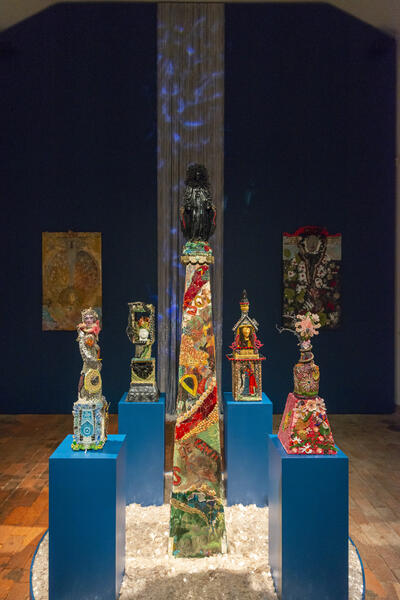 "Traces of the Spirit" ○ Baltimore Museum of Art ○ 2019"Traces of the Spirit" is a 2019 installation at the Baltimore Museum of Art in the Spring House. It's a series of separate spirit sculptures representing family, seasons, pilgrimage and Haitian folklore. The center sculpture entitled "Saint for my City" was acquired by the BMA in 2020 and is in response to perceived needs for spiritual affirmation in Baltimore. The round pedestal is filled with mica stone chips.
"Traces of the Spirit" ○ Baltimore Museum of Art ○ 2019"Traces of the Spirit" is a 2019 installation at the Baltimore Museum of Art in the Spring House. It's a series of separate spirit sculptures representing family, seasons, pilgrimage and Haitian folklore. The center sculpture entitled "Saint for my City" was acquired by the BMA in 2020 and is in response to perceived needs for spiritual affirmation in Baltimore. The round pedestal is filled with mica stone chips. -
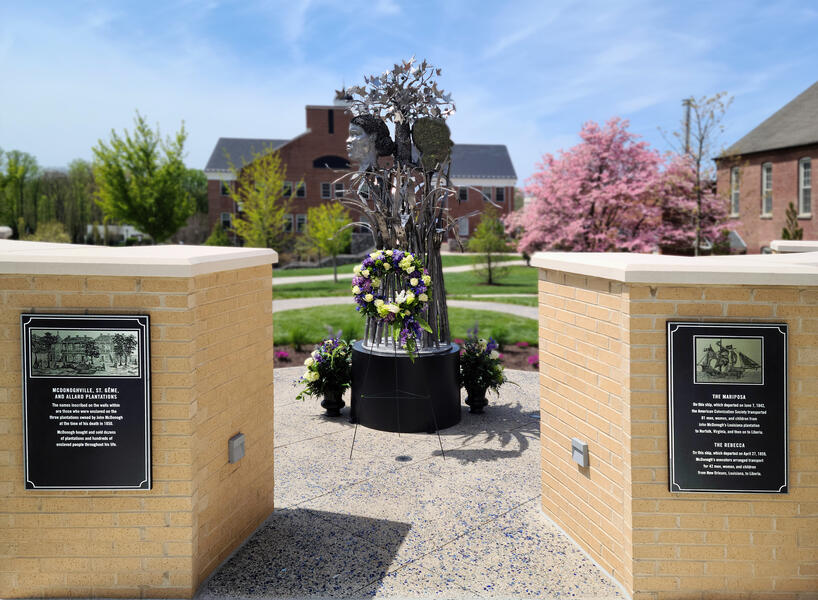 Memorial to Those Enslaved and Freed ○ 2022The 2022 "Memorial to Those Enslaved and Freed" recognizes and honors Black men, women, and children who, through their forced labor, made John McDonogh, the founder of McDonogh School, a wealthy man. The public art site recognizes the aspiration and the resilience of a people who served in a capacity that made them invisible.
Memorial to Those Enslaved and Freed ○ 2022The 2022 "Memorial to Those Enslaved and Freed" recognizes and honors Black men, women, and children who, through their forced labor, made John McDonogh, the founder of McDonogh School, a wealthy man. The public art site recognizes the aspiration and the resilience of a people who served in a capacity that made them invisible. -
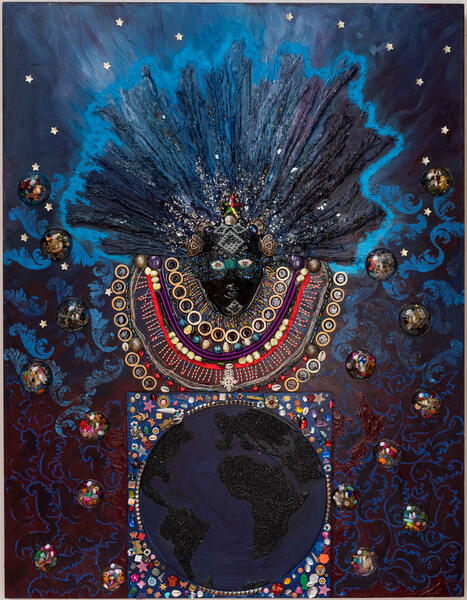 Mawu-Moon Goddess ○ 2019Title: Mawu-Moon Goddess ○ Year: 2019 ○ Material: wood, acrylic, glass, beads, rope, resin on wood panel ○ Dimensions: 54" x 36" x 1.5" ○○ "Mawu-Moon Goddess" is part of a series of mixed-media works about the human condition and our relationship to realms beyond us. The creation of large-scale figural representation of mythological and religious entities personify universal concepts and are identified as Avatars.
Mawu-Moon Goddess ○ 2019Title: Mawu-Moon Goddess ○ Year: 2019 ○ Material: wood, acrylic, glass, beads, rope, resin on wood panel ○ Dimensions: 54" x 36" x 1.5" ○○ "Mawu-Moon Goddess" is part of a series of mixed-media works about the human condition and our relationship to realms beyond us. The creation of large-scale figural representation of mythological and religious entities personify universal concepts and are identified as Avatars.
About Oletha
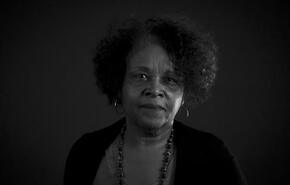
Born in Baltimore, Maryland, Oletha DeVane received her B.F.A. from the Maryland Institute College of Art and M.F.A. in painting from the University of Massachusetts in Amherst. As a multidisciplinary artist, her social, political and spiritual concerns are the content of her art practice. Her first major exhibition was at the Springfield Museum of Art in Massachusetts in 1976. Since then, she has been featured in numerous solo and group exhibitions locally and internationally. The… more
From The Realm of Dust
Across painting, printmaking, sculpture, video, mosaic, and mixed media works ranging from tiny and intimate objects to monumental panels, DeVane’s creative sensibilities leave no stone unturned in her quest to communicate her vision of the painful and troubled specificities of black American history side by side with her embrace of a pan-spiritual relationship to the divine. In the fabrication of her intricate and totemic sculptures, DeVane embodies the modularity and tactility of Constantin Brancusi, the additive processes and reach to verticality of David Smith, and the dazzling juxtaposition of materials of Mickalene Thomas.
Her work reflects an awareness of global artistic practices and a strategic use of American craft sensibilities that is situated within her profound roots in the local Baltimore creative community. She is part of a newly recognized generation of artists whose work explodes the narrow, constricted narrative of modernist art to make way for a more inclusive awareness of the pluralities and richness of American contemporary artistic production.
- Christopher Bedford
_____
"From the Realm of Dust" is a series of mixed media works about the human condition and our relationship to realms beyond us. The creation of large-scale figural representation of mythological and religious entities personifies universal concepts and are identified as Avatars.
Examples of the goddesses in this series are those like MAWU, a deity represented in "Mawu-Moon Goddess, who is worshiped in coastal West Africa by the Fon. She is seen as a creator and is associated with the moon.
The piece "Dumballa" represents a deity in the African-based religion of Vodou in Haiti. He takes the form of a snake and is an agent of fertility.
"Erzulie" is the Haitian goddess of love and power. She is invoked as a symbol of female courage, desirability and strength, and symbolizes the ideal mother.
"The Lote Tree" marks the boundary where no soul is allowed to pass any further. Archangel Gabriel guards the passage. In Islamic lore, the Lote Tree marks the utmost boundary through which no one can pass. It is the tree that the Prophet Mohammed encountered at the climax of his legendary nocturnal ascent to heaven. This important number recurs in the seven earths and seven underworlds that pervade many philosophical traditions. The mystical writings of Baha’u’llah, founder of the Baha’is faith, defines the wayfarer's journey as The Seven Valleys and The Four Valleys.
In the Greek myth "Dog Star", Sirius-Asteria scorched the Minoan Islands from the sky and was thought to have brought about the destruction of mankind. By doing so , he was responsible for saving the lives of the rest.
Several of these pieces synchronize spiritual beliefs represented in a myriad of cultures.
-
 Mawu-Moon GoddessYear: 2019 ○ Material: wood, acrylic, glass, beads, rope, resin on wood panel ○ Dimensions: 54" x 36" x 1.5" ○○ MAWU is a deity worshiped in coastal West Africa by the Fon. She is seen as a creator and is associated with the moon.
Mawu-Moon GoddessYear: 2019 ○ Material: wood, acrylic, glass, beads, rope, resin on wood panel ○ Dimensions: 54" x 36" x 1.5" ○○ MAWU is a deity worshiped in coastal West Africa by the Fon. She is seen as a creator and is associated with the moon. -
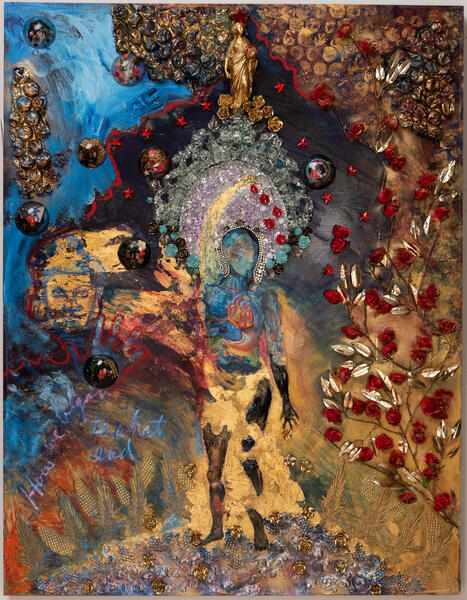 Sirius-AsteriaYear: 2020 ○ Material: glass, fabric, acrylic, wood, paper ○ Dimensions: 54" x 36" x 1.5" ○○ Greek myth "Dog Star" Sirius-Asteria scorched the Minoan Islands from the sky and was thought to have brought about the destruction of mankind. By so doing, he was responsible for saving the lives of the rest.
Sirius-AsteriaYear: 2020 ○ Material: glass, fabric, acrylic, wood, paper ○ Dimensions: 54" x 36" x 1.5" ○○ Greek myth "Dog Star" Sirius-Asteria scorched the Minoan Islands from the sky and was thought to have brought about the destruction of mankind. By so doing, he was responsible for saving the lives of the rest. -
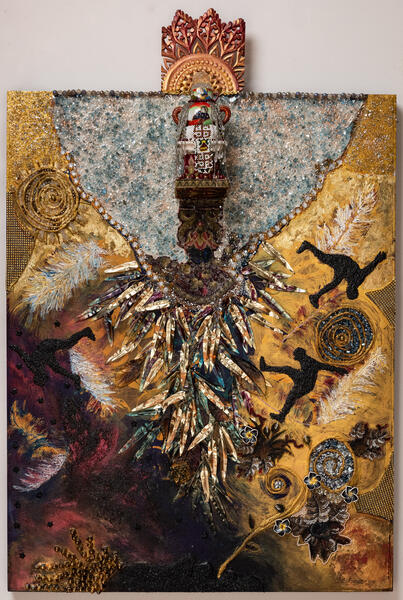 Whatever happened to Icarus?Year: 2020 ○ Material: acrylic, glass chips, rope, ceramic, wood, plastics ○ Dimensions: 56" x 34" x 1.5" In Whatever Happened to Icarus?, the son of Dadaelus of Greek mythology is seen in sequence spinning down to earth, his wings having been destroyed by the sun’s heat. The presence below scornfully observes the presumptions of Icarus to transcend his natural state as he falls to the sea.
Whatever happened to Icarus?Year: 2020 ○ Material: acrylic, glass chips, rope, ceramic, wood, plastics ○ Dimensions: 56" x 34" x 1.5" In Whatever Happened to Icarus?, the son of Dadaelus of Greek mythology is seen in sequence spinning down to earth, his wings having been destroyed by the sun’s heat. The presence below scornfully observes the presumptions of Icarus to transcend his natural state as he falls to the sea. -
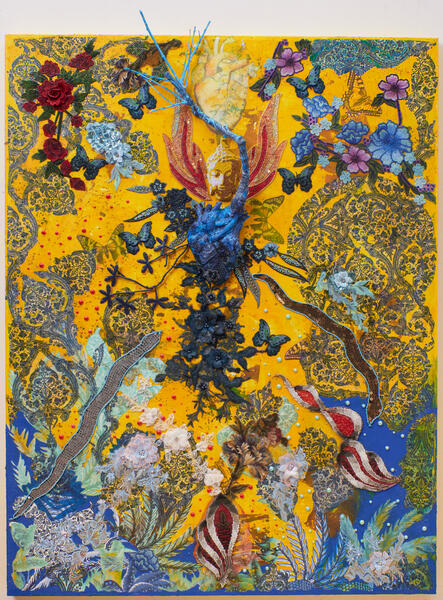 The Garden of the HeartTitle: Garden of the Heart ○ Year: 2020
The Garden of the HeartTitle: Garden of the Heart ○ Year: 2020 -
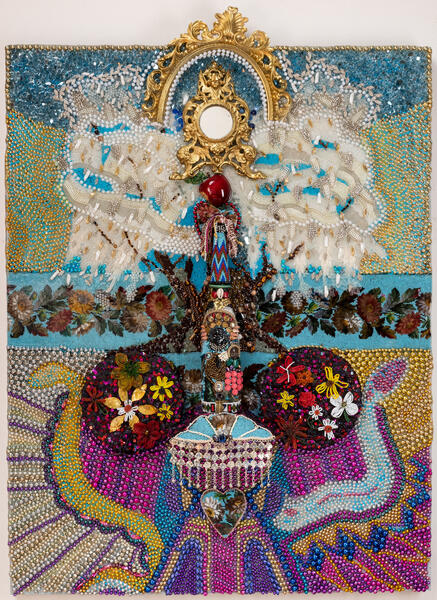 The Lote TreeYear: 2020 ○ Material: beads, ceramic, fabric, glass, wood ○ Dimensions: 56" x 34" x 1.5 " ○ ○ The lote tree marks the boundary where no soul is allowed to pass any further. Archangel Gabriel guards the passage. In Islamic lore, the Lote Tree marks the utmost boundary through which no one can pass. It is the tree that the Prophet Mohammed encountered at the climax of his legendary nocturnal ascent to heaven. This important number recurs in the seven earths and seven underworlds that pervade many philosophical traditions. The mystical writings of Baha’u’llah, founder of the Baha’is faith, defines the wayfarer's journey asThe Seven Valleys and The Four Valleys.
The Lote TreeYear: 2020 ○ Material: beads, ceramic, fabric, glass, wood ○ Dimensions: 56" x 34" x 1.5 " ○ ○ The lote tree marks the boundary where no soul is allowed to pass any further. Archangel Gabriel guards the passage. In Islamic lore, the Lote Tree marks the utmost boundary through which no one can pass. It is the tree that the Prophet Mohammed encountered at the climax of his legendary nocturnal ascent to heaven. This important number recurs in the seven earths and seven underworlds that pervade many philosophical traditions. The mystical writings of Baha’u’llah, founder of the Baha’is faith, defines the wayfarer's journey asThe Seven Valleys and The Four Valleys. -
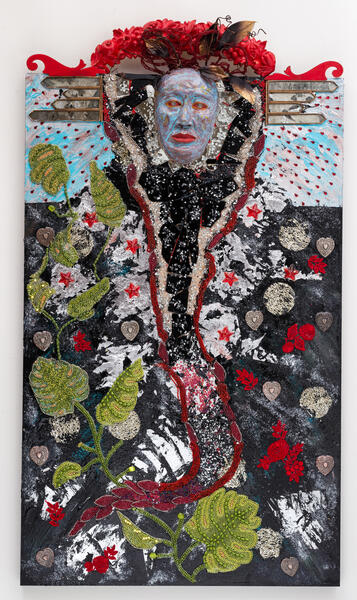 DumballaYear: 2018 ○ Material: acrylic on panel, glass, beads, resin, crystals, clay, wood, fabric, metal ○ Dimensions: 53" x 30" x 3"
DumballaYear: 2018 ○ Material: acrylic on panel, glass, beads, resin, crystals, clay, wood, fabric, metal ○ Dimensions: 53" x 30" x 3" -
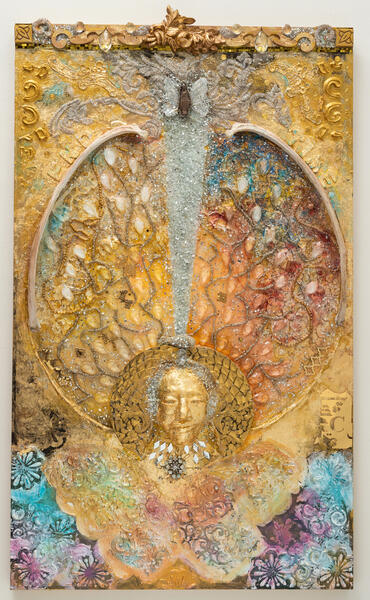 EpiphanyYear: 2018 ○ Material: wood, glass, acrylic paint, bones, plastics ○ Dimensions: 52"x 30"x 3.5"
EpiphanyYear: 2018 ○ Material: wood, glass, acrylic paint, bones, plastics ○ Dimensions: 52"x 30"x 3.5" -
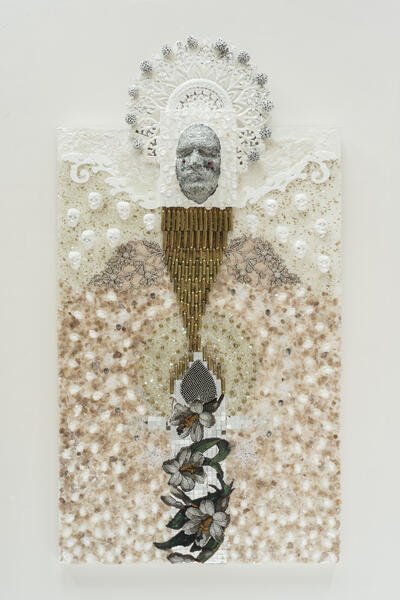 Subsumed by WhitenessAn avatar representing the challenge of the black body encased in whiteness, shielded by bullets, facing death, and reaching transcendence.
Subsumed by WhitenessAn avatar representing the challenge of the black body encased in whiteness, shielded by bullets, facing death, and reaching transcendence. -
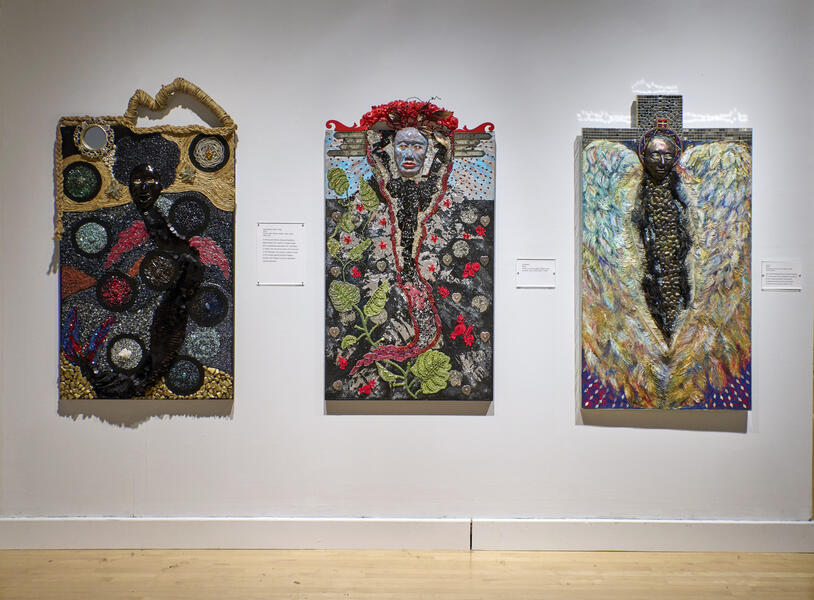 Installation View ○ Mamawata (left) | Dumballa (center) | Erzulie (right)In African and African diaspora traditions, Mama Wata is the mother of oceans/water. She is sometimes associated with mermaids, or sirens, who can tempt sailors off course and to their demises. Her mythos is deeply rooted in the coastal regional stories of Nigeria, Zambia, and Thailand, and thus represents a global presence. Dumballa is a deity in the African-based religion of Voudu in Haiti. He takes the form of a snake and is an agent of fertility. Erzulie, the Haitian goddess of love and power. She is invoked as a symbol of female courage, desirability and strength, and symbolizes the ideal mother,
Installation View ○ Mamawata (left) | Dumballa (center) | Erzulie (right)In African and African diaspora traditions, Mama Wata is the mother of oceans/water. She is sometimes associated with mermaids, or sirens, who can tempt sailors off course and to their demises. Her mythos is deeply rooted in the coastal regional stories of Nigeria, Zambia, and Thailand, and thus represents a global presence. Dumballa is a deity in the African-based religion of Voudu in Haiti. He takes the form of a snake and is an agent of fertility. Erzulie, the Haitian goddess of love and power. She is invoked as a symbol of female courage, desirability and strength, and symbolizes the ideal mother, -
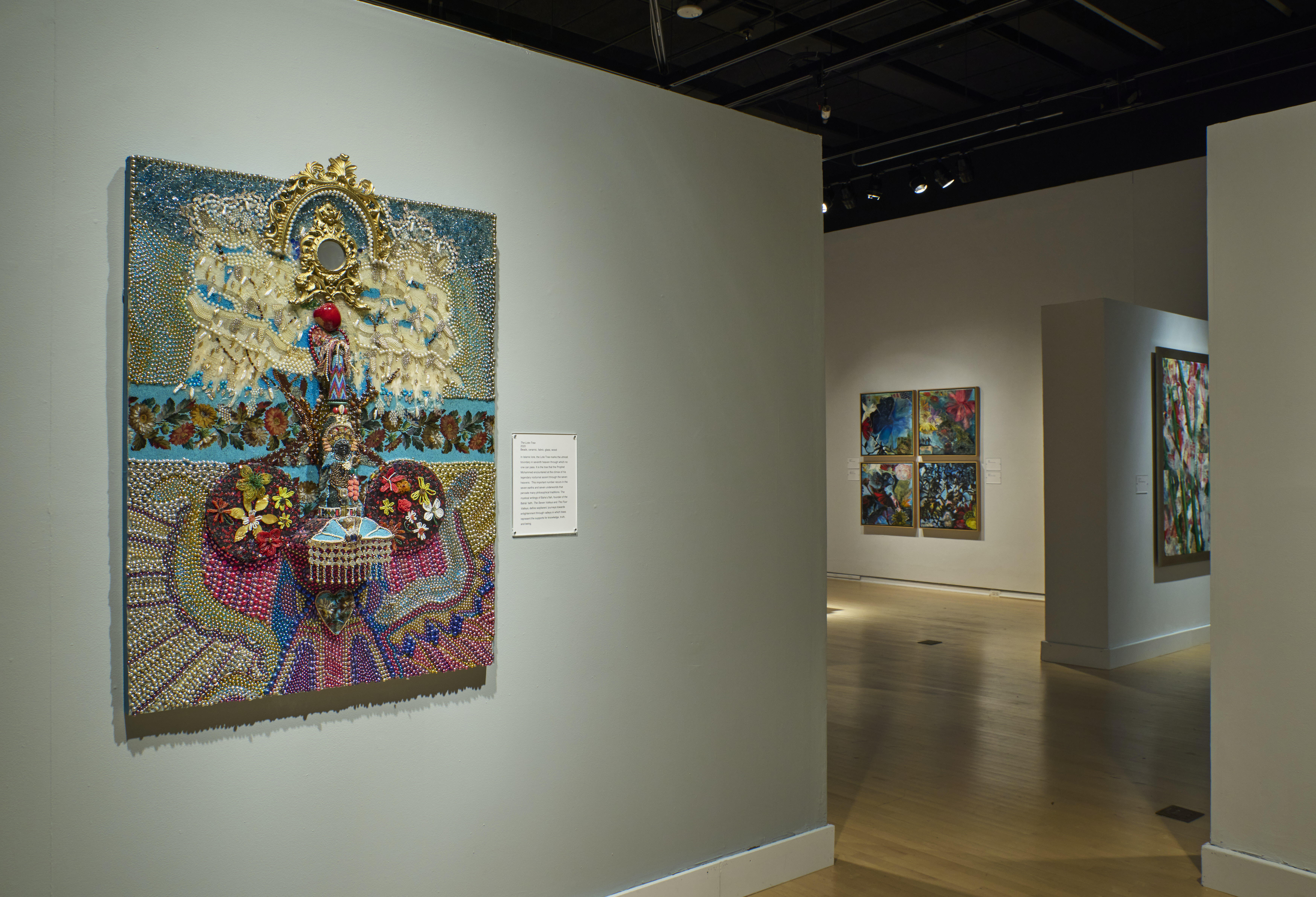 The Lote Tree (UMBC exhibition) 2022The Lote Tree: One of several works in the 2022 Retrospective Exhibition: Spectrum of Light and Spirit at University of Maryland Baltimore County (UMBC)
The Lote Tree (UMBC exhibition) 2022The Lote Tree: One of several works in the 2022 Retrospective Exhibition: Spectrum of Light and Spirit at University of Maryland Baltimore County (UMBC)
Public Art
Public art moves us from within, moves us in its legacy and gives us a conduit to reimagine the world. This is a body of work that promotes the recovery of a collected past meant to elicit a deeper understanding and fuller perspective to the history of the United States.
The ‘Memorial to those Enslaved and Freed’ in Owings Mills, MD is a multi-part memorial created to establish as clearly as possible the relationship between John McDonogh’s wealth and the institution of slavery. Such a relationship needs to be understood on multiple levels. On the broadest level, slavery was interwoven socially, politically, and especially economically in the development of the United States during McDonogh’s life. More specifically, McDonogh’s circumstances placed him at the center, rather than on the periphery, of this system.
The bust of the public monument is cast from molds I designed as I reimagined the faces of enslaved individuals connected to John McDonogh. More fully, the sculpture pays homage to hundreds of people who labored as slaves on McDonogh’s estates in Louisiana. The names are found on a granite water-wall flanked by seating space for those who come to reflect on its history. The Memorial to Those Enslaved and Freed is meant to make the lives of Black people who were enslaved by John McDonogh visible. The people whose names are on the wall were laborers, teachers, ministers, healers, farmers, and children who we now know and acknowledge. They were part of the nation’s wealth-building and will no longer be silenced.
The memorial represents the collective journey to embrace the contributions and the lives of many individuals—their achievement, resistance, and spiritual resilience came at a high cost in the moral darkness of America. Full consideration was also given to the plants surrounding the memorial, where sweet gum trees and herbal flowers were planted. Two plaques detail the history of Black and Brown people connected to McDonogh’s plantations and the voyages they embarked to return to Africa by way of Virginia.
The piece entitled ‘Robert and Rosetta’ realizes an invariable history of Baltimore’s Lexington Market to show how the market was used, and more specifically, the people who had been assertively noticed on its grounds during the relegated times of slavery. I followed a vision that prioritized reflection and reclamation of space using ornamental forged metal and cut design.
‘Robert & Rosetta’ reveals the stories of two modest, yet notable individuals who seismically shift the idea behind ‘exchanging goods’ in Lexington Market. In recognizing Rosetta, and her counterpart Robert, my team wanted to cue onlookers, in a very approachable way, with two granite ground flagstones etched with newspaper articles from the Baltimore Sun (1838) and the American Commercial & Daily Advertiser (1833). The oversized pavers mimic granite stand-markers that still line the curbs in the area today to challenge how public space had been used throughout the United States, and unassumingly, is indicated in the history of Lexington Market.
-
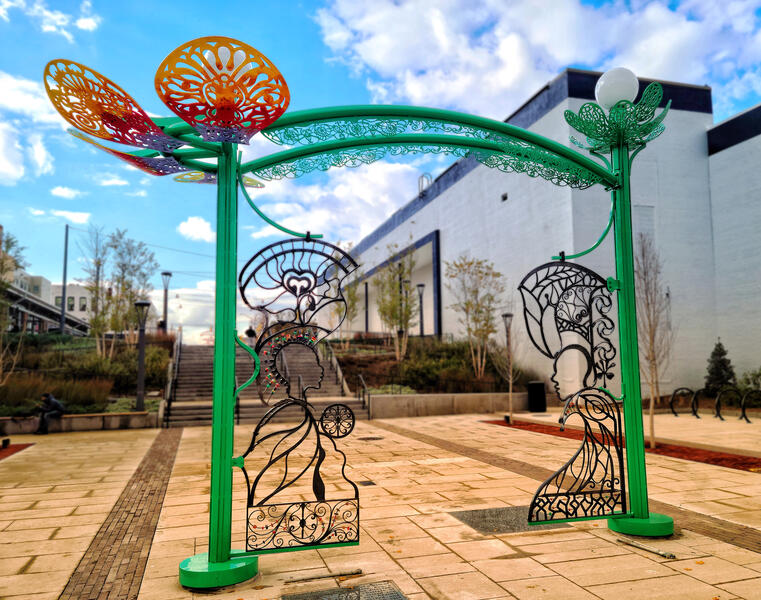 Robert & Rosetta ○ Facing West21.5 ft (center canopy edge to center light post edge) x 14ft (width) x 16ft (height). Center post (Robert support) to center post (Rosetta support) 14ft.
Robert & Rosetta ○ Facing West21.5 ft (center canopy edge to center light post edge) x 14ft (width) x 16ft (height). Center post (Robert support) to center post (Rosetta support) 14ft. -
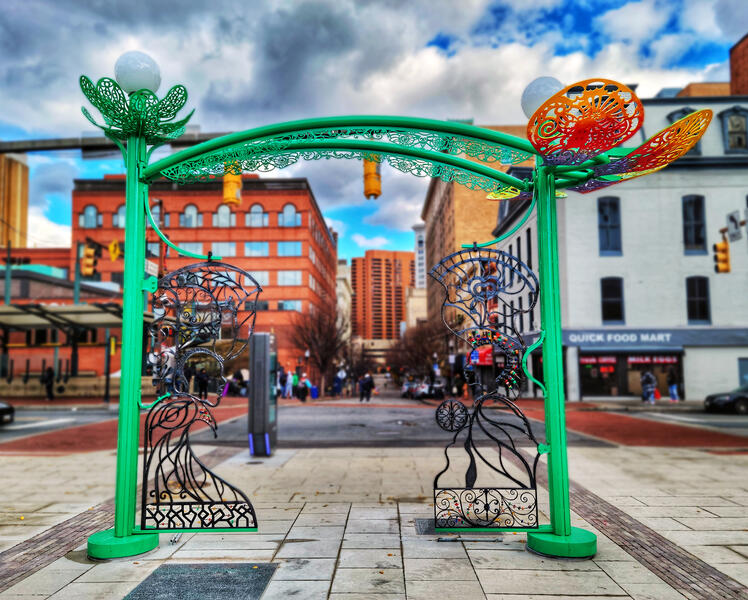 Robert & Rosetta ○ Facing Eutaw StreetThe structure is made from 4" and 8" steel pipe, with canopy panels made with 1⁄2” and 1⁄4” inch steel plate that is cut in accordance to drawing designs. Robert and Rosetta paneling is made of forged steel ranging in size from 1⁄2” square to 2” inch square bars.
Robert & Rosetta ○ Facing Eutaw StreetThe structure is made from 4" and 8" steel pipe, with canopy panels made with 1⁄2” and 1⁄4” inch steel plate that is cut in accordance to drawing designs. Robert and Rosetta paneling is made of forged steel ranging in size from 1⁄2” square to 2” inch square bars. -
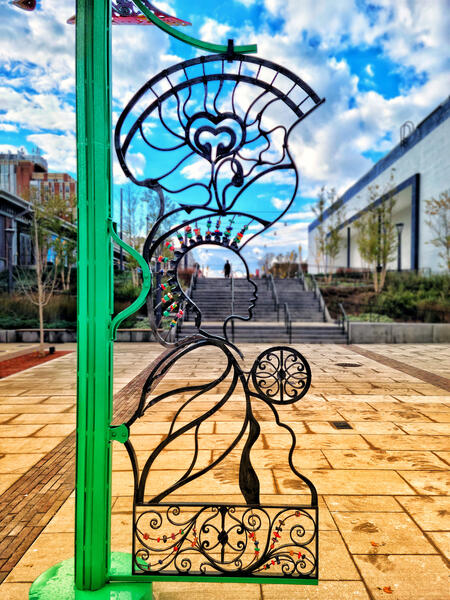 Rosetta PanelTwo granite pavers with newspaper inscriptions will run parallel to the Robert and Rosetta panels on opposing sides measuring 42” x 42” (Robert article) and 28” x 36” (Rosetta article). Light posts sit above each panel
Rosetta PanelTwo granite pavers with newspaper inscriptions will run parallel to the Robert and Rosetta panels on opposing sides measuring 42” x 42” (Robert article) and 28” x 36” (Rosetta article). Light posts sit above each panel -
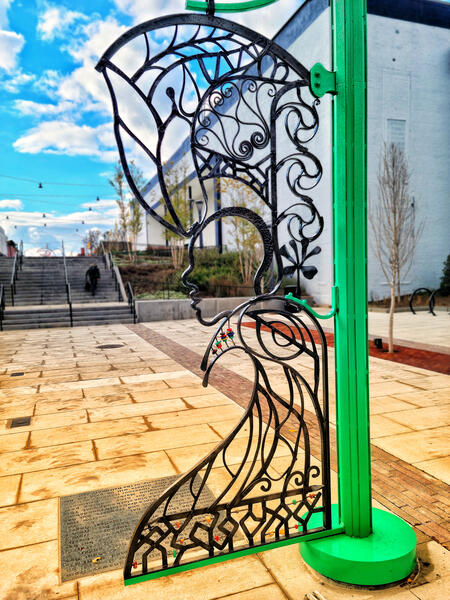 Robert PanelBeads adorn each panel and allow for interactive movement and play
Robert PanelBeads adorn each panel and allow for interactive movement and play -
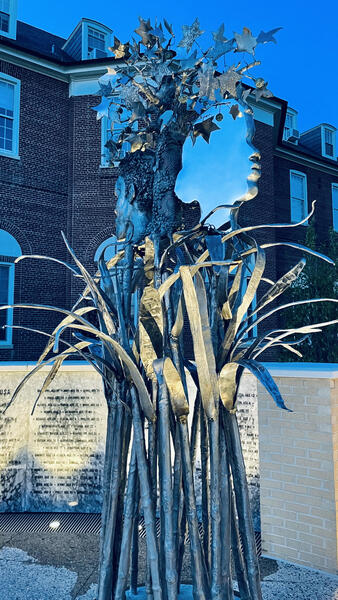 Memorial to Those Enslaved and Freed
Memorial to Those Enslaved and Freed -
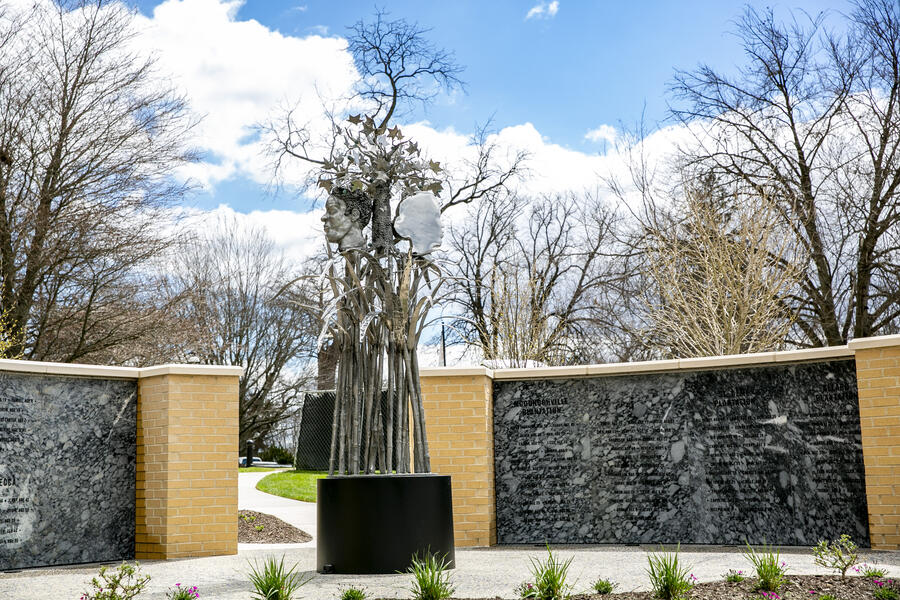 Memorial to Those Enslaved and Freed
Memorial to Those Enslaved and Freed -
Memorial to Those Enslaved and Freed
-
Memorial to Those Enslaved and Freed
-
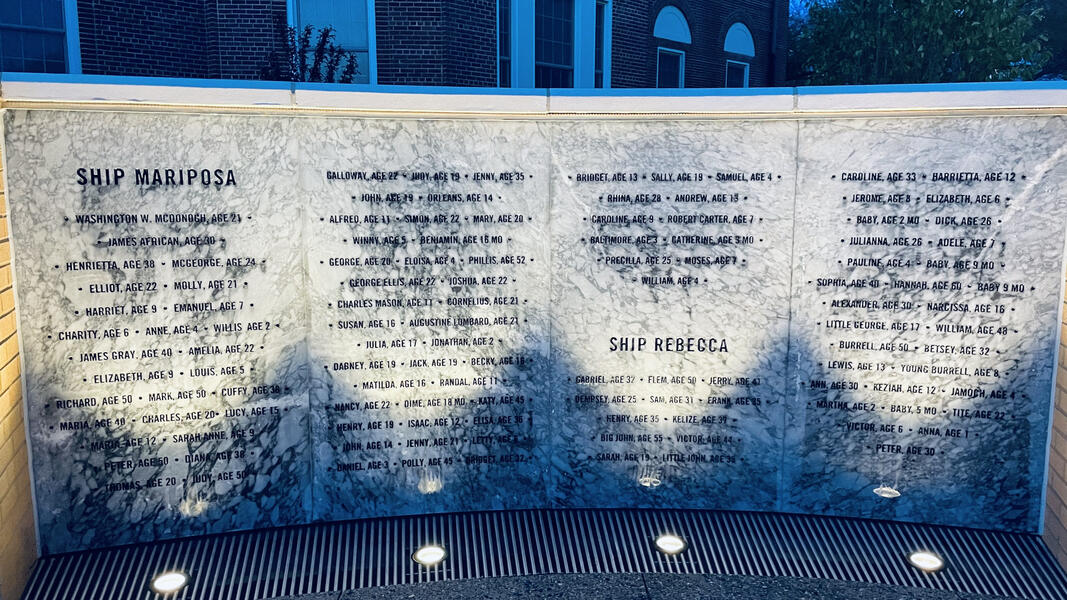 Memorial to Those Enslaved and FreedA water wall of names of those enslaved opens to the garden in the front.
Memorial to Those Enslaved and FreedA water wall of names of those enslaved opens to the garden in the front. -
Memorial To Those Enslaved And Freed - Artist Reflection 2023The memorial is in an outdoor oval garden, defined by a low brick wall on which people are welcome to sit and reflect. The space provides an active, vibrant teaching and learning environment for quiet work, reflection, and contemplation.
Spirit Sculptures
The principal catalyst for the emergence of DeVane’s spirit sculptures was a gift she received of an ornate Haitian bottle from a fellow artist, William Rhodes. Artists throughout the African diaspora of the Americas have been actively exploring how to reclaim the aesthetic agency of their traditional African heritages in the aftermath of the horrors of the Middle Passage, slavery in the Americas, and the relentless assaults of racism into present time. These diasporic artists are continually studying, researching, and seeking ways and means to reconnect with the traditions, culture, religions, and belief systems of their motherland.
The bottle gifted to DeVane embodies characteristics reflective of similar bottles as described by Robert Farris Thompson in his seminal study Flash of the Spirit as: ingenious reformulations of (Kongo) nkisi charms, sometimes called pacquets- congo.... The more elegant pacquets are wrapped in silk instead of ancestral cotton or raffia cloth; are tied with broad silk ribbons (secured with pins) instead of cord; are adorned with sequins as well as beads; and sometimes crowned with plumes made of metallic cloth instead of actual feathers. These charms are containers—usually constructed from old bottles—that become a body or vessel to house a spirit, into which “medicines” are inserted to create protections from evil or to stimulate the presence of the “flash of the spirit.” Rhodes’ gift initiated a period of deep contemplation and artistic inspiration for DeVane, inspiring her sculptural series.
The surfaces of the bottles, vessels, containers, and totems of DeVane’s sculptures are always festooned and riddled—literally, figuratively, and symbolically—with clustered embellishments and layered elements of ordinary, mundane, sometimes even boring materials that by themselves would be simply unremarkable. Within DeVane’s psyche, combined with her technical prowess for assemblage, she remembers and reimagines found, castoff materials. These works are conceived by the technique of bricolage with which she leverages the use of available materials. Those materials fuel and load her sculptures with symbolic signifiers of intangible and often uncontrollable, inexplicable forces, which include the crucial dynamics of being human and coexisting with otherworldly beings. She explains how “[t]he spirit sculptures emerged as a concept to harness blessings and explore the intuitive, irrational, or unconscious phenomena.” DeVane’s artistic vision radiates the presence of life forces in the world, in present time or beyond— to otherworldly spaces where gods, spirits, and ancestors reside. In Songs of Orpheus (2008), for example, a bottle form is covered with a beaded netting, with dangling beads at the neck and the base of the sculpture. A clay head is affixed to the top facing upward, as Orpheus sings his rapturous songs to otherworldly gods. Sprouting from the head is a wired, beaded headdress alluding to the harmonic and arresting sounds of his songs. The cumulative effect of combining fragmented objects that still embody energies from a functional past life transforms her sculptures into icons of power, authority, and beauty.
- Dr. Leslie King Hammond
-
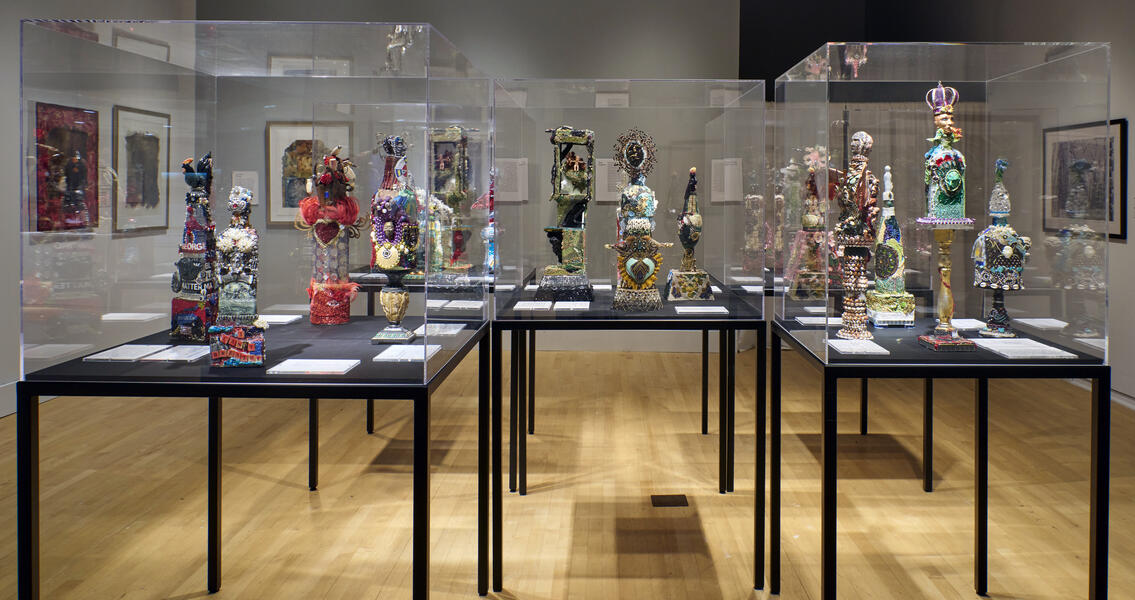 Spirit Sculpture InstallationSpirit Sculptures”—elaborately assemblaged glass bottles, which are prominently featured in this exhibition are intended as altar offerings for various orishas/loas. These ordinary beverage bottles are transformed by the application of sequins, fabric and beads.
Spirit Sculpture InstallationSpirit Sculptures”—elaborately assemblaged glass bottles, which are prominently featured in this exhibition are intended as altar offerings for various orishas/loas. These ordinary beverage bottles are transformed by the application of sequins, fabric and beads. -
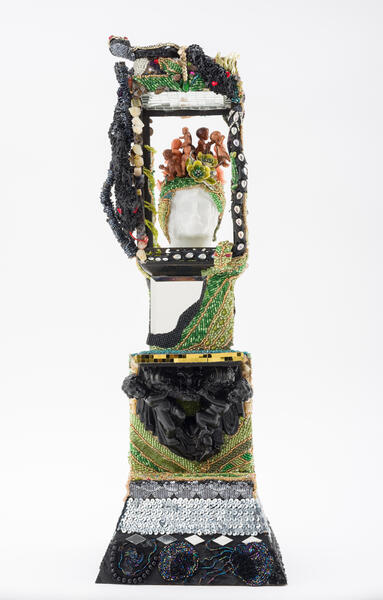 Woman Who Married a SnakeWoman Who Married a Snake ○ 2017 ○ glass, metal, beads, plastics, mirrors, pebbles) ○ 26" x 9" x 9" ○ ○ Ayida-Weddo is a fertility spirit and she is known as the Rainbow Serpent. Her story originates in Benin and Haitian lore.
Woman Who Married a SnakeWoman Who Married a Snake ○ 2017 ○ glass, metal, beads, plastics, mirrors, pebbles) ○ 26" x 9" x 9" ○ ○ Ayida-Weddo is a fertility spirit and she is known as the Rainbow Serpent. Her story originates in Benin and Haitian lore. -
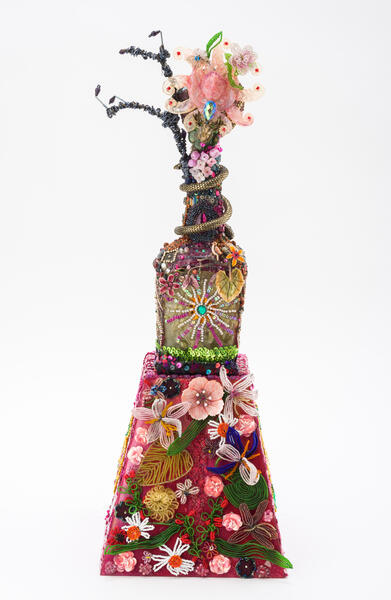 SpringSeasonal celebration of life
SpringSeasonal celebration of life -
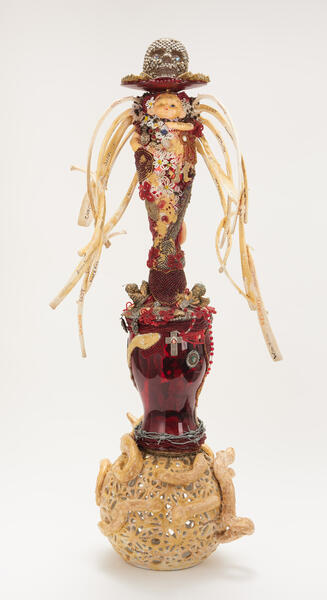 Fall from Grace2013 ○ glass, wax, beads, bones and plastic ○ “Fall From Grace, which features a beaded skull atop a repurposed bottle and glowing orb, combines religious vocabulary with contemporary concerns. Serpents wind around the glass bottle, and a splayed ribcage of bone-like fans sprout from just beneath the skull. A few words are hand-written on the bone-like appendages—”lust,” “deviant,” “wanton”—that allude to the sins of the flesh that have scandalized churches and the religious right. Even powerful people entrusted with the divine light aren’t free of human sin.”
Fall from Grace2013 ○ glass, wax, beads, bones and plastic ○ “Fall From Grace, which features a beaded skull atop a repurposed bottle and glowing orb, combines religious vocabulary with contemporary concerns. Serpents wind around the glass bottle, and a splayed ribcage of bone-like fans sprout from just beneath the skull. A few words are hand-written on the bone-like appendages—”lust,” “deviant,” “wanton”—that allude to the sins of the flesh that have scandalized churches and the religious right. Even powerful people entrusted with the divine light aren’t free of human sin.” -
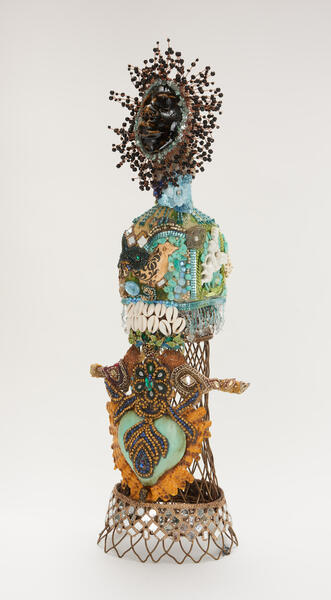 TranscendTranscend ○ 2022
TranscendTranscend ○ 2022 -
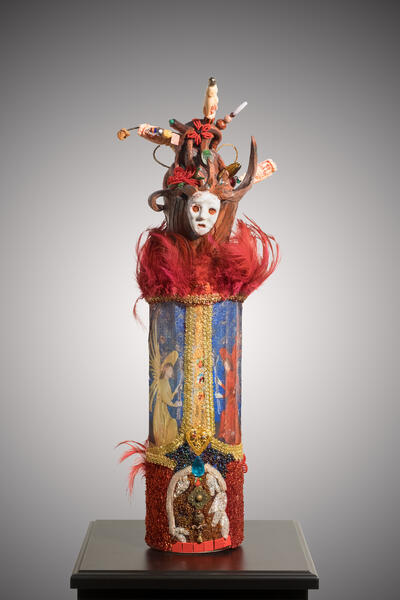 MedievalMedieval ○ 2017 ○ 23" x 9" x 6" ○ glass, red feathers, wire, fabric, plastic, wood, beads ○○ Medieval represents the Dark Ages of our times with the angels on either side are protective spirits. It's colors are the trickster.
MedievalMedieval ○ 2017 ○ 23" x 9" x 6" ○ glass, red feathers, wire, fabric, plastic, wood, beads ○○ Medieval represents the Dark Ages of our times with the angels on either side are protective spirits. It's colors are the trickster. -
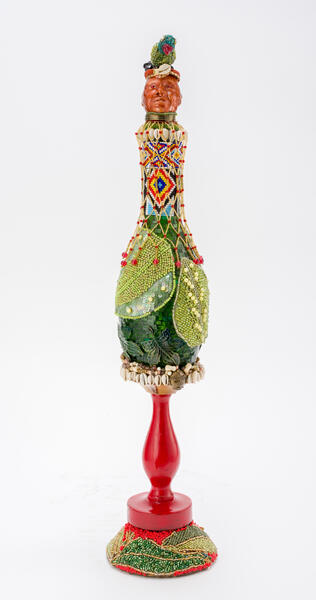 OrishaOrisha ○ 2017 ○ 38" x 10"x 11" ○ wood, clay, sequin fabric, glass, beads
OrishaOrisha ○ 2017 ○ 38" x 10"x 11" ○ wood, clay, sequin fabric, glass, beads -
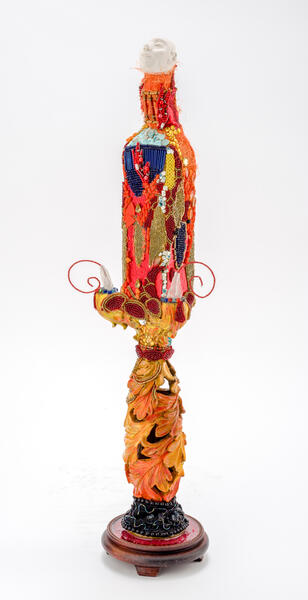 Samuel's DreamSamuel’s Dream ○ 2012 ○ wood, resin, glass, clay, glass beads, metal wire, fabric, turquoise, acrylic paint ○ Collection Homewood Museum, Johns Hopkins University ○○. In this work references to a passage from the book of Samuel in the Old Testament of the Bible, which describes how Samuel was called to his spiritual mission by God in a dream. While making this piece, I thought of a spirited young man I met who was battling a drug addiction. He was one of eight people who lost their lives in a New Orleans warehouse fire where he fell asleep. He was called to a higher purpose through the Second Line musical parade that concluded his funeral ceremony serving as a means to ease his passage forward.
Samuel's DreamSamuel’s Dream ○ 2012 ○ wood, resin, glass, clay, glass beads, metal wire, fabric, turquoise, acrylic paint ○ Collection Homewood Museum, Johns Hopkins University ○○. In this work references to a passage from the book of Samuel in the Old Testament of the Bible, which describes how Samuel was called to his spiritual mission by God in a dream. While making this piece, I thought of a spirited young man I met who was battling a drug addiction. He was one of eight people who lost their lives in a New Orleans warehouse fire where he fell asleep. He was called to a higher purpose through the Second Line musical parade that concluded his funeral ceremony serving as a means to ease his passage forward. -
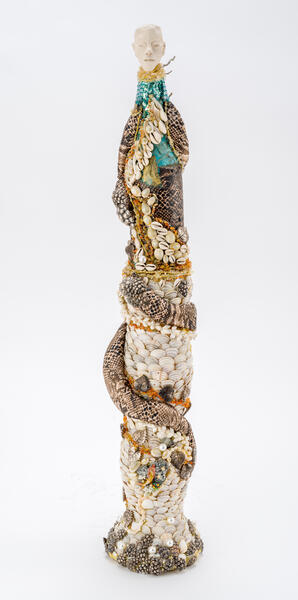 Elegba/DumballaElegba (Dumballa) ○ 2008 ○ glass beads, shells, clay, fabric., metal , clay, plastic, wood ○○ Cross-references Dumballa[h], the Haitian loa who is a benevolent father figure, with Elegba, the Yoruba, who can be seen variously as, as messenger, the guardian of the crossroads and the trickster. This juxtaposition is created more from the place of poetry personifying the relationship between Dumballah and Elegba through the symbology of the snake. In African-based traditions this reptile can be seen as an agent of creativity and regeneration as it sheds its skin, as opposed to the more malevolent reputation it has in Christianity, as the tempter of Eve in the Garden of Eden.
Elegba/DumballaElegba (Dumballa) ○ 2008 ○ glass beads, shells, clay, fabric., metal , clay, plastic, wood ○○ Cross-references Dumballa[h], the Haitian loa who is a benevolent father figure, with Elegba, the Yoruba, who can be seen variously as, as messenger, the guardian of the crossroads and the trickster. This juxtaposition is created more from the place of poetry personifying the relationship between Dumballah and Elegba through the symbology of the snake. In African-based traditions this reptile can be seen as an agent of creativity and regeneration as it sheds its skin, as opposed to the more malevolent reputation it has in Christianity, as the tempter of Eve in the Garden of Eden. -
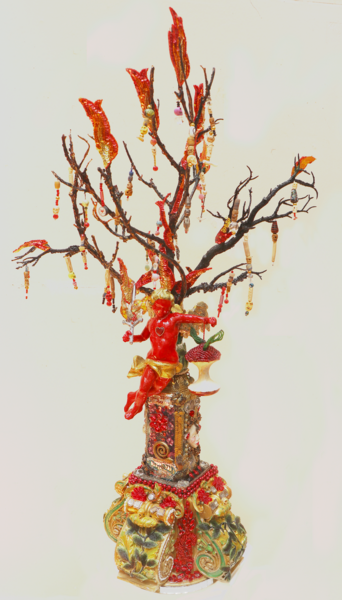 Gates Of Eden"Gates of Eden" (work in progress) 36"h x 22"long 10.5 @base beads, wood, angel plaster, fabrics, sequins
Gates Of Eden"Gates of Eden" (work in progress) 36"h x 22"long 10.5 @base beads, wood, angel plaster, fabrics, sequins
Prints
DeVane began as a painter-printmaker—creating beautiful, often haunting imagery of dense landscapes that evoked scenarios and longings of struggle, a sense of being, place, liberation, and freedom. Her aesthetic is deeply affected by W.E.B DuBois’ concept of “double consciousness”—living simultaneously in a black and white world—or what Paul Gilroy has described as “the processes of cultural mutation and restless (dis)continuity” given the biases of Western canons and the benign recognition of the confluences of African diasporic aesthetic practices.
The life of an artist is in many ways about a very personal journey in the discovery of a sense of self in relationship to the world in which she lives. What becomes of that adventure—its discoveries, revelations, epiphanies, tragedies, and triumphs— are revealed as one seeks to find meaning from “uncontrolled events.” The struggle to survive, protect, and prevail hopefully yields lessons or wisdoms from the knowledge accumulated via those experiences and that are then imparted to the creation of an artistic vision.
- Dr. Leslie King-Hammond
-
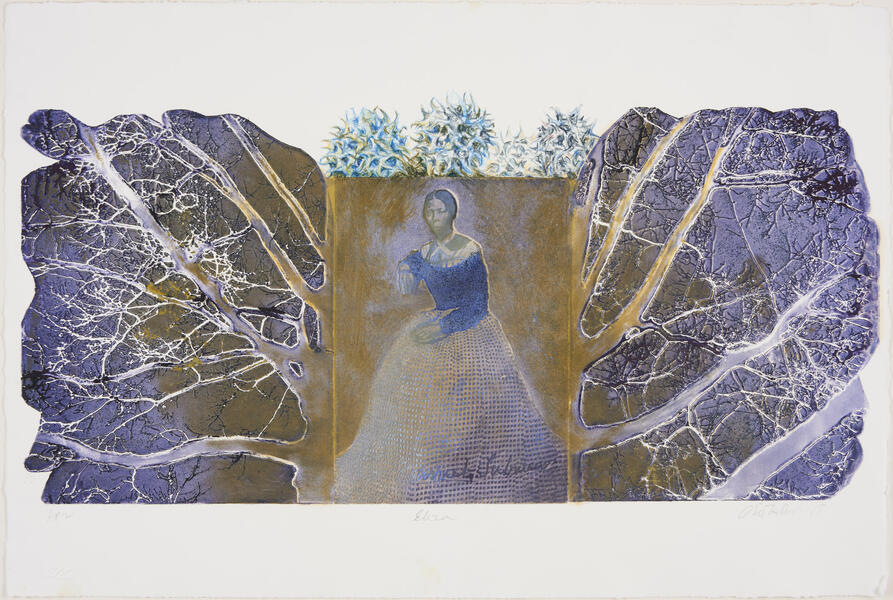 Sweetgum and HarrietSweetgum and Harriet ○ 2017 ○ solar etching ○○ Sweetgum tree/ balls reference Kate Clifford Larson’s book “Bound for the Promise Land”. Larson describes sweet gum balls as, “… large, round, balls covered with spiny, burrs. They litter the forest floor sometimes inches deep, nature’s bed of nails…” Those seedpods, once the medicine with aromatic therapeutic fragrance to the slaves;... would then, “pierce the calloused, unprotected feet of terrified runaway slaves. The seeds from the sweet gum tree would be among the first obstacles on the road to freedom.”
Sweetgum and HarrietSweetgum and Harriet ○ 2017 ○ solar etching ○○ Sweetgum tree/ balls reference Kate Clifford Larson’s book “Bound for the Promise Land”. Larson describes sweet gum balls as, “… large, round, balls covered with spiny, burrs. They litter the forest floor sometimes inches deep, nature’s bed of nails…” Those seedpods, once the medicine with aromatic therapeutic fragrance to the slaves;... would then, “pierce the calloused, unprotected feet of terrified runaway slaves. The seeds from the sweet gum tree would be among the first obstacles on the road to freedom.” -
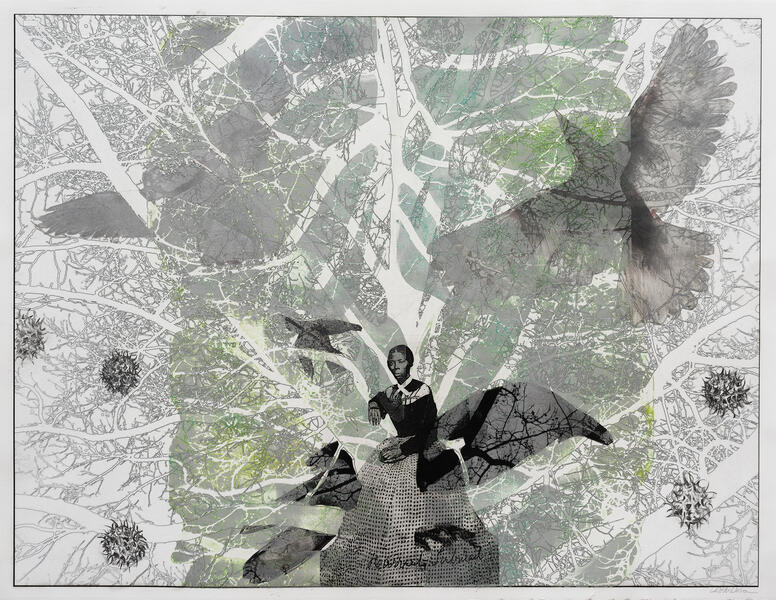 Harriet in sweetgumHarriet in Sweetgum tree ○ 22" x 36" ○ solar etching ○ 2018
Harriet in sweetgumHarriet in Sweetgum tree ○ 22" x 36" ○ solar etching ○ 2018 -
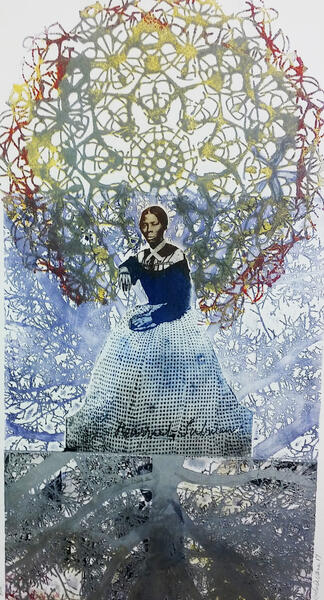 MintyMinty ○ 2017 ○ solar etching of young Harriet Tubman in Sweet gum tree ○ 16" x 22"
MintyMinty ○ 2017 ○ solar etching of young Harriet Tubman in Sweet gum tree ○ 16" x 22" -
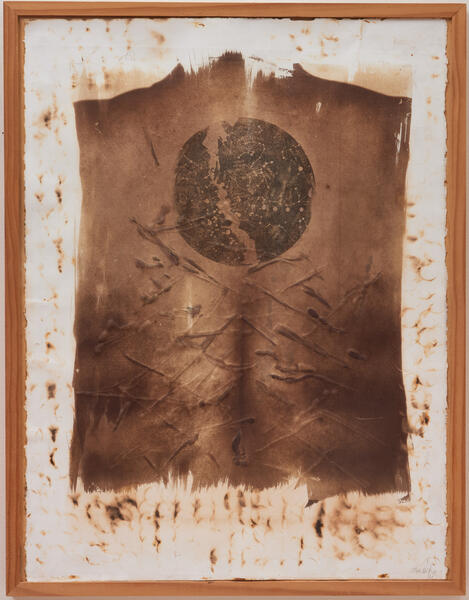 StarmapStar map ○ 22" x 30" ○ 2010 ○ Harriet Tubman series (works on paper) ○ Van dyke and burnt marks on rives paper
StarmapStar map ○ 22" x 30" ○ 2010 ○ Harriet Tubman series (works on paper) ○ Van dyke and burnt marks on rives paper -
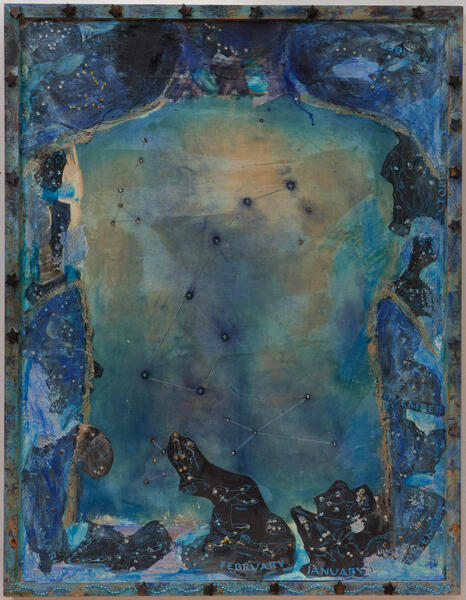 Drinking gourdDrinking Gourd (from H.Tubman series) ○ 2010 ○ 22" x 30" ○ cyanotype, wood, fabric, sequins, acrylic
Drinking gourdDrinking Gourd (from H.Tubman series) ○ 2010 ○ 22" x 30" ○ cyanotype, wood, fabric, sequins, acrylic -
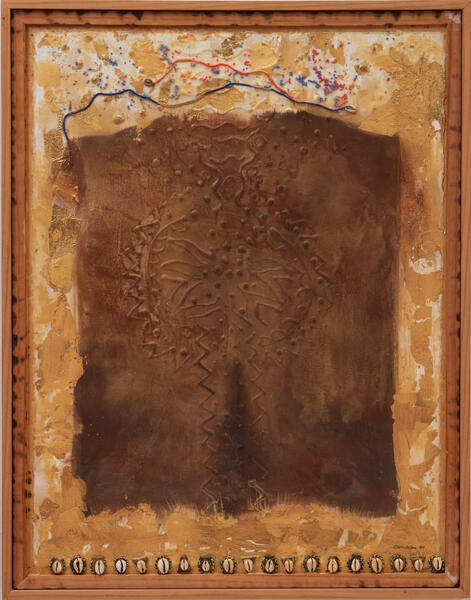 OracleOracle ○ 22" x 30"
OracleOracle ○ 22" x 30" -
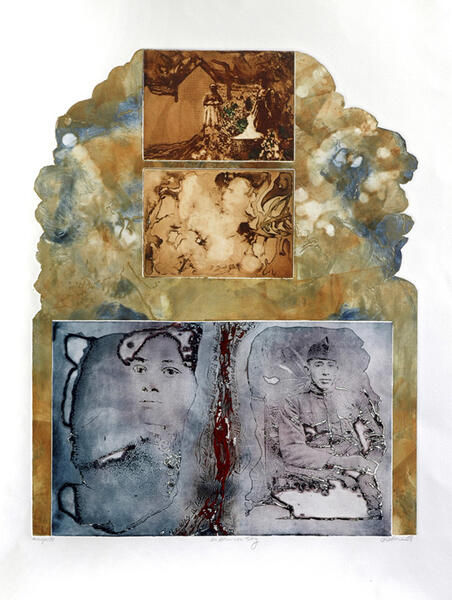 An American storyAn American Story ○ 2009 solar etching using found and archival images ○ The soldier is from WWI; the woman circa 1860's and photos of cotton pickers.
An American storyAn American Story ○ 2009 solar etching using found and archival images ○ The soldier is from WWI; the woman circa 1860's and photos of cotton pickers. -
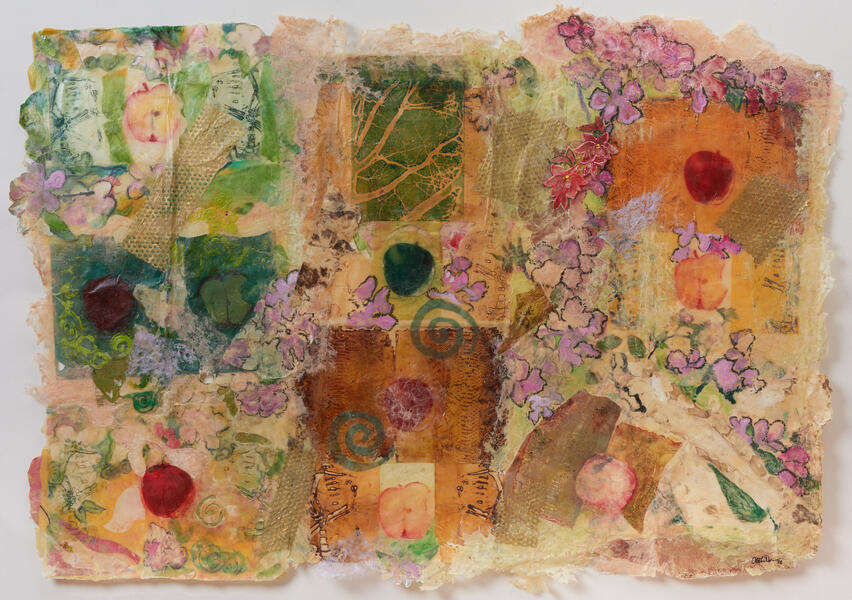 GardenGarden ○ 2015 ○ Encaustic. ○ 54"(length) x 4.5 ft (width)
GardenGarden ○ 2015 ○ Encaustic. ○ 54"(length) x 4.5 ft (width) -
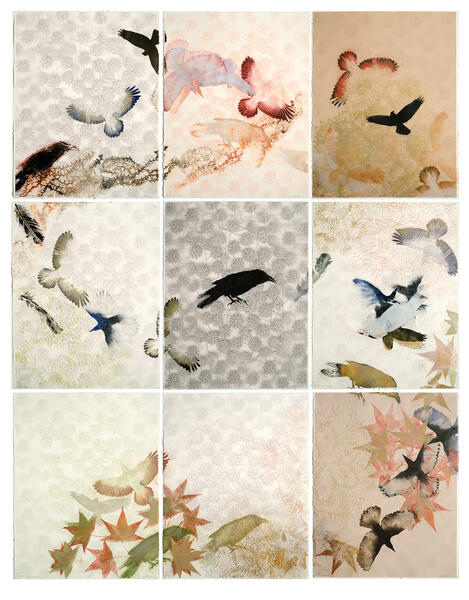 Call to FreedomCall to Freedom ○ nine solar etchings ○ 99"(h) x 66"(w) ○○ The raven represents Harriet Tubman while the sweet gum balls are large round, seedpods covered with spiny, burrs. Nature’s "bed of nails piercing the calloused, unprotected feet of terrified runaway slaves. The sweet gum tree would be among the first obstacles on the road to freedom.”
Call to FreedomCall to Freedom ○ nine solar etchings ○ 99"(h) x 66"(w) ○○ The raven represents Harriet Tubman while the sweet gum balls are large round, seedpods covered with spiny, burrs. Nature’s "bed of nails piercing the calloused, unprotected feet of terrified runaway slaves. The sweet gum tree would be among the first obstacles on the road to freedom.” -
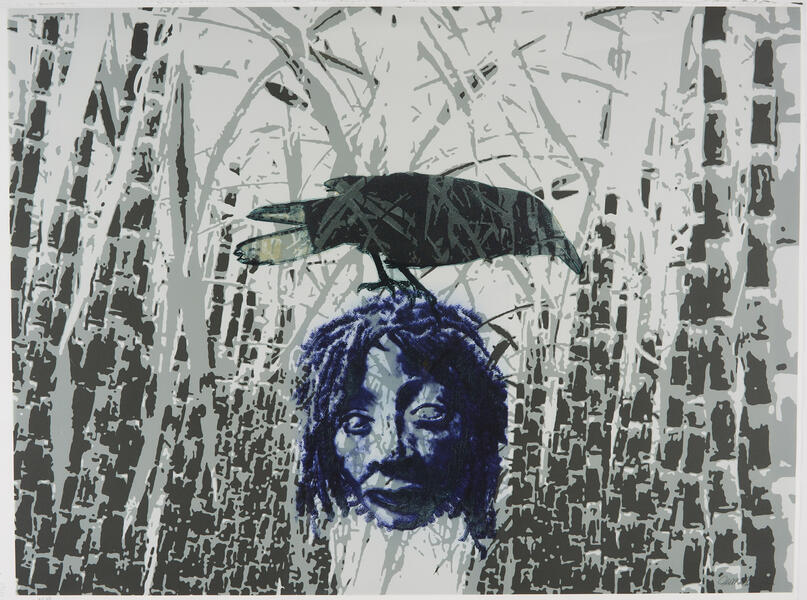 Sugarcane BluesSugarcane Blues ○ 2020 solar/digital etching on Rives paper ○ 22" x 30"
Sugarcane BluesSugarcane Blues ○ 2020 solar/digital etching on Rives paper ○ 22" x 30"
Sculpture
Oletha DeVane can be counted among a distinguished roster of artists, including Betye Saar, Howardena Pindell, Joyce J. Scott, Renée Stout, and Vanessa German, who each in their own way have engaged in an art- making process that Linda Goode-Bryant and Marcy S. Philips once described as encapsulating “energy, mysticism, automatism, and ritual process.” Working in media as various as painting, sculpture, collage, assemblage, and object-making and performance, they tell their personal stories in the context of the resilient and vital cultural expressions of the African diaspora in the Americas, bringing ancestral materialist-making into the contemporary dimension.
...
This approach to art-making, which Goode-Bryant and Philips first identified in the late 1970s, became the provenance of artists who defied the prevailing minimalist aesthetic that focused on abstraction, non-objectivity, and the “pure” plastic elements of art-making. As seen in the work of individuals such as Betye Saar, doyenne of West Coast assemblage, these artists even surpassed the vaunted material aspects of postminimalism, the term that art historian Robert Pincus-Witten coined to describe the work of artists including Robert Morris and Eva Hesse, who were working with materials such as felt, latex, and fiberglass. Saar’s The Mystic Window #1 (1965), for example, used the collaging of different materials to engage us with her pertinent and poetic juxtapositions of found objects that reflected the occult essence of African American and Caribbean culture. For Saar, this type of “ritual process”—however improvised and personal—involves several conditions, which she identified for this author in 1988, and these conditions might be brought to bear on an analysis of the work of DeVane.
- Dr. Lowery Stokes Sims
-
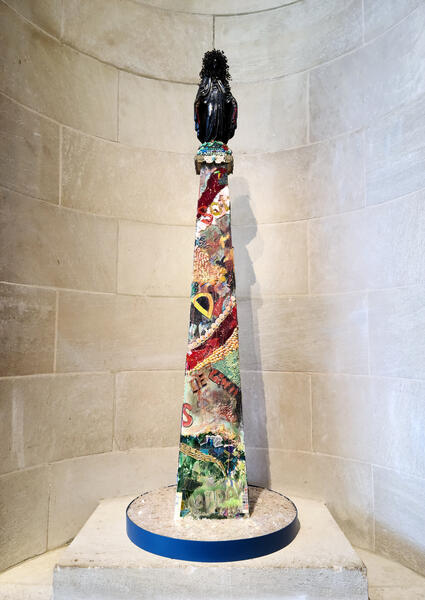 St. for My City ○ Baltimore Museum of ArtSt. for my City 2007-10 ○ Features a familiar statue of the Virgin Mary with a modified black face as an urban saint. The total form is painted black— evoking the cults of the “Black Madonna”—and is embellished with an elaborate headdress of black beads. The pedestal is painted and collaged to evoke the various names for God and was created as a memoir for all persons who have died from gun violence.
St. for My City ○ Baltimore Museum of ArtSt. for my City 2007-10 ○ Features a familiar statue of the Virgin Mary with a modified black face as an urban saint. The total form is painted black— evoking the cults of the “Black Madonna”—and is embellished with an elaborate headdress of black beads. The pedestal is painted and collaged to evoke the various names for God and was created as a memoir for all persons who have died from gun violence. -
 Saint for My CitySaint for My City ○ 2007-2010 ○ 86 7/8 x 12 7/8 x 13” ○ glass, wood, bullet casings, encaustic, plastic, fabric, mirror, acrylic paint, metal, porcelain
Saint for My CitySaint for My City ○ 2007-2010 ○ 86 7/8 x 12 7/8 x 13” ○ glass, wood, bullet casings, encaustic, plastic, fabric, mirror, acrylic paint, metal, porcelain -
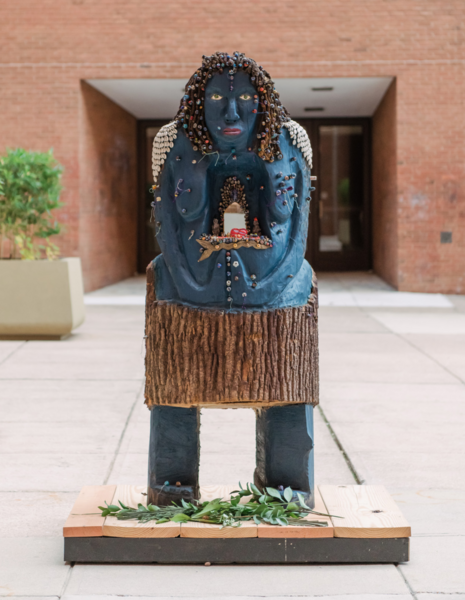 UNIVERSAL NKISI WOMAN 2021-22Nkisi Woman-Universal nkisi ○ 2021-22 ○ 74"(h) x 34" (d) ○ carved wood, beads, paint ○ ○ The interactive sculpture can be seen as evoking cultural expressions of the African diaspora in the Americas, bringing ancestral materialist-making into the contemporary dimension. I carved the large scale figural sculpture of universal N'kisi as an object invested with sacred energy—that will be festooned with beads by visitors to the exhibition as a group manifestation of community and communion.
UNIVERSAL NKISI WOMAN 2021-22Nkisi Woman-Universal nkisi ○ 2021-22 ○ 74"(h) x 34" (d) ○ carved wood, beads, paint ○ ○ The interactive sculpture can be seen as evoking cultural expressions of the African diaspora in the Americas, bringing ancestral materialist-making into the contemporary dimension. I carved the large scale figural sculpture of universal N'kisi as an object invested with sacred energy—that will be festooned with beads by visitors to the exhibition as a group manifestation of community and communion. -
Spectrum of Light - Nkisi Activation Ceremony
-
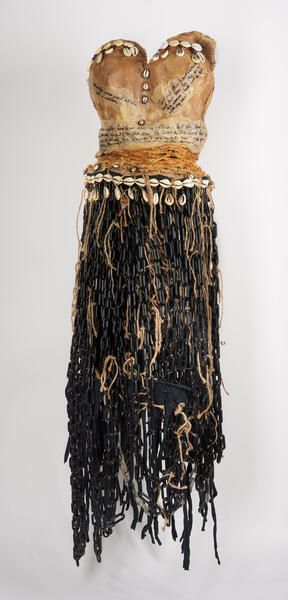 Hagar's Dress in her exileHAGAR’S DRESS IN HER EXILE ○ 2012 ○ chains, hemp cord, fabric, beads, sweet gum balls, cowrie shells ○○ This piece is a dress assembled from chains, rope and burlap. The inner core is wire, fabric and some plaster. The floor is covered with spiky "sweet gum balls" which were to be walked on barefoot by participants who wanted to get closer to the dress. The choice of materials reference the struggle for freedom…The story of Hagar resonates with generations of black women who struggle to hold their families together and in the Harriet Tubman story, people walked across fields of sweet gum ball when they escaped through the Underground Railroad. The story of Hagar metaphorically validates the struggle and strength to endure injustice and was particularly of interest to the African American stories in church.
Hagar's Dress in her exileHAGAR’S DRESS IN HER EXILE ○ 2012 ○ chains, hemp cord, fabric, beads, sweet gum balls, cowrie shells ○○ This piece is a dress assembled from chains, rope and burlap. The inner core is wire, fabric and some plaster. The floor is covered with spiky "sweet gum balls" which were to be walked on barefoot by participants who wanted to get closer to the dress. The choice of materials reference the struggle for freedom…The story of Hagar resonates with generations of black women who struggle to hold their families together and in the Harriet Tubman story, people walked across fields of sweet gum ball when they escaped through the Underground Railroad. The story of Hagar metaphorically validates the struggle and strength to endure injustice and was particularly of interest to the African American stories in church. -
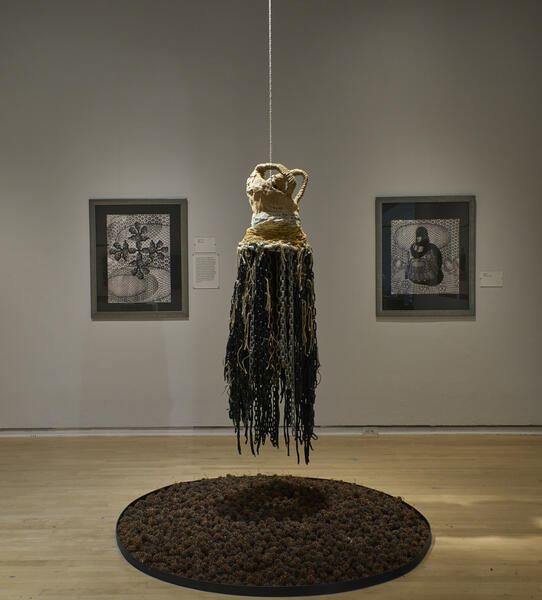 Hagar's dress installationHAGAR’S DRESS IN HER EXILE 2012 ○ chains, hemp cord, fabric, beads, cowrie shells over a circle of sweet gum balls ○○ The story of Hagar resonates with generations of black women who struggle to hold their families together and in the Harriet Tubman story, people walked across fields of sweet gum ball when they escaped through the Underground Railroad. The story of Hagar metaphorically validates the struggle and strength to endure injustice and was particularly of interest to the African American stories in church.
Hagar's dress installationHAGAR’S DRESS IN HER EXILE 2012 ○ chains, hemp cord, fabric, beads, cowrie shells over a circle of sweet gum balls ○○ The story of Hagar resonates with generations of black women who struggle to hold their families together and in the Harriet Tubman story, people walked across fields of sweet gum ball when they escaped through the Underground Railroad. The story of Hagar metaphorically validates the struggle and strength to endure injustice and was particularly of interest to the African American stories in church. -
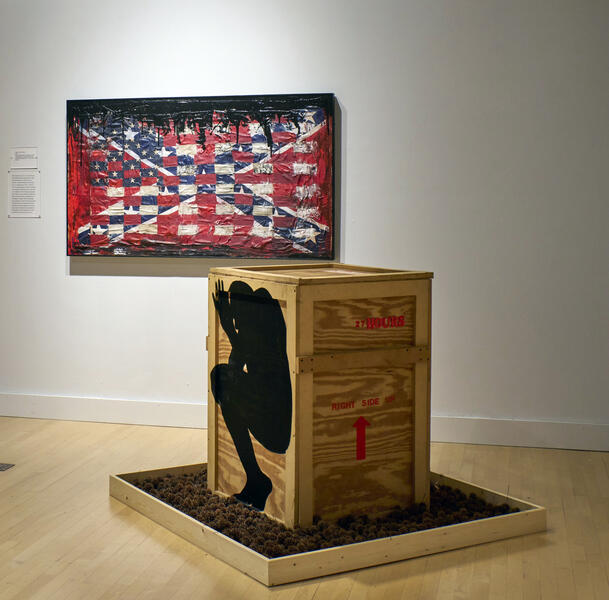 Henry "Box" BrownHenry “Box” Brown ○ 2015 ○ 50"(h) x 38"(w) x 60"(d) ○ wood, acrylic paint, sweet gum balls | USA flag fabric, Confederate flag fabric, acrylic paint on canvas
Henry "Box" BrownHenry “Box” Brown ○ 2015 ○ 50"(h) x 38"(w) x 60"(d) ○ wood, acrylic paint, sweet gum balls | USA flag fabric, Confederate flag fabric, acrylic paint on canvas -
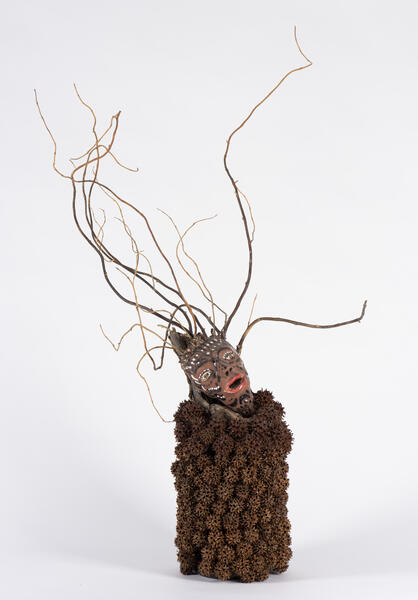 ESCAPEEscape ○ 2016 ○ wood, clay, branches, sweet gum balls
ESCAPEEscape ○ 2016 ○ wood, clay, branches, sweet gum balls -
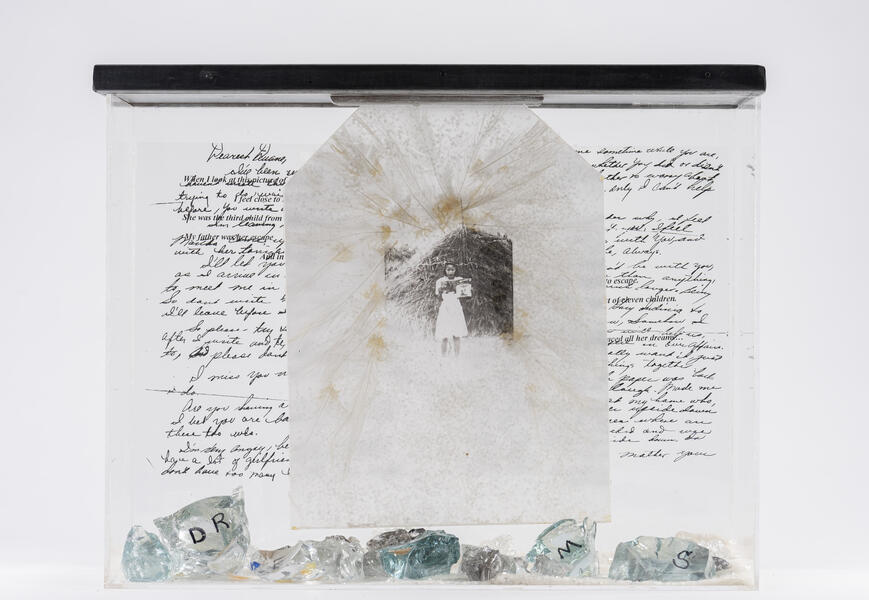 A Letter to JohnA letter to John 2010 a handwritten letter from my mom to my father. Plexiglass box with photo image transfer and glass with the word "dream".
A Letter to JohnA letter to John 2010 a handwritten letter from my mom to my father. Plexiglass box with photo image transfer and glass with the word "dream". -
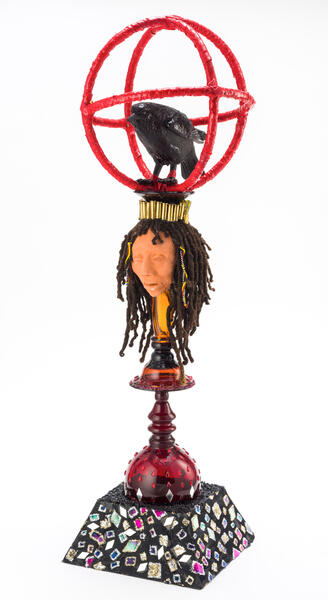 GeminiGemini ○ 2018 ○ 38" x 10" x 11" ○ wood, clay, hair, metal, sequin fabric, glass, bullet casings, beads
GeminiGemini ○ 2018 ○ 38" x 10" x 11" ○ wood, clay, hair, metal, sequin fabric, glass, bullet casings, beads
Sacred Geometry - Book Arts
This large-scale artist book includes images by DeVane and poetry by Washington-based educator, Donna Denize, that was created in response to the Garrett Collection in the library at the Evergreen House, which is a part of the Johns Hopkins University Museums. "The book is inspired from many sources… although my purpose in structuring the book using the circle, triangle and the square was to explore their cosmological symbolism. In West African cosmic thought, the circular motion or spiral constitutes the human soul in a cycle of life that has no end."
"I chose two books about explorations and journeys, The Discovered Lands of Virginia by Thomas Hariot and a letter, The Discovered Islands, by Christopher Columbus. Both presented complex ironies about colonialism and the exotic or mythic illustrations of indigenous peoples. I decided to use the 'metaphorical' journey of the soul as the idea for the mixed media painted pages of the book. The poetry reflects a trip to Italy, where Donna and I met to discuss the art and architecture.”
Sacred Geometry is a book art project [collaboration with poet Donna Denize] created in 2001 with 9 double-folio mixed media collages with poetry.
-
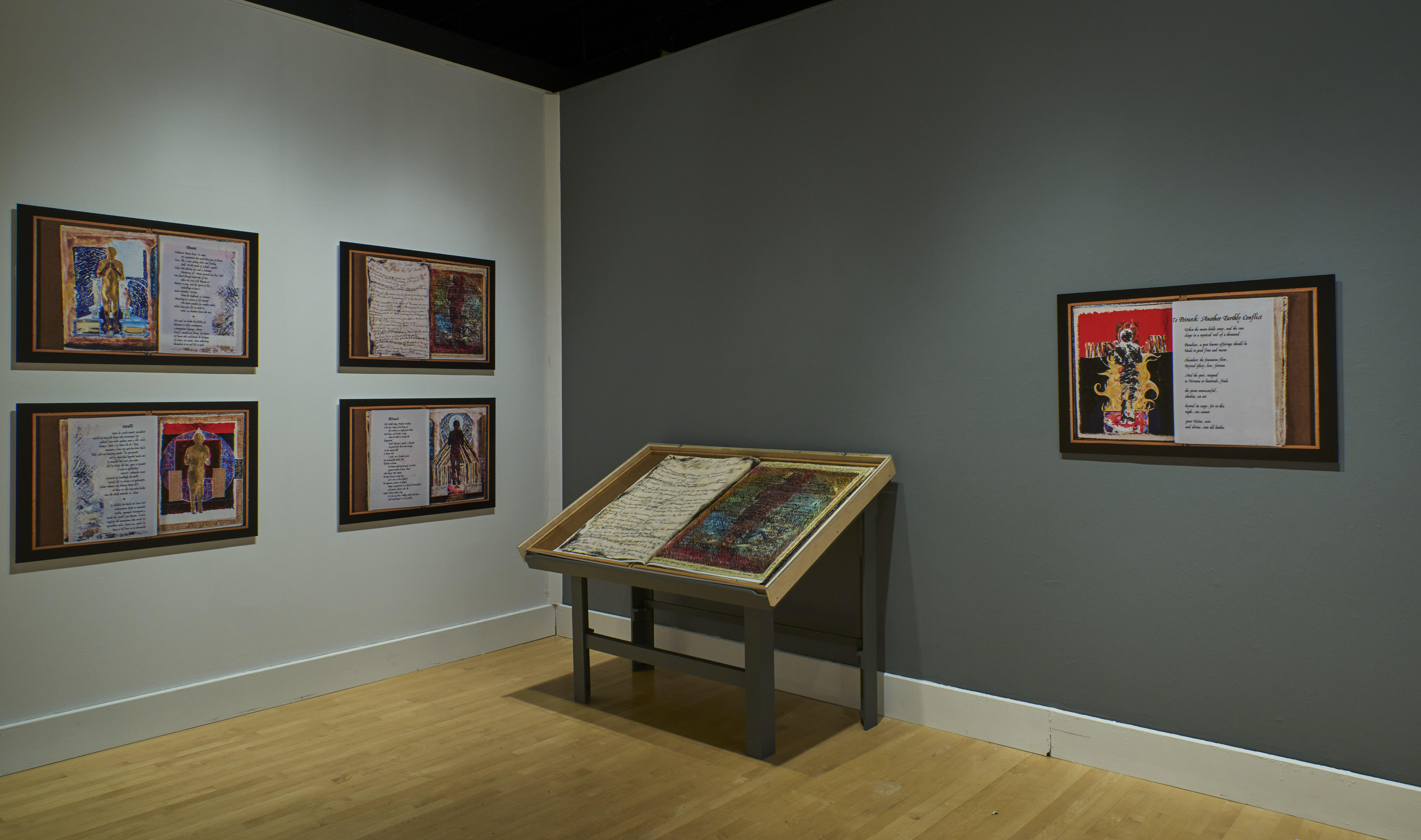 Sacred Geometry ○ InstallationSacred Geometry ○ 2001 ○ 52"x 68" (open book) ○ Installation at UMBC retrospective exhibition
Sacred Geometry ○ InstallationSacred Geometry ○ 2001 ○ 52"x 68" (open book) ○ Installation at UMBC retrospective exhibition -
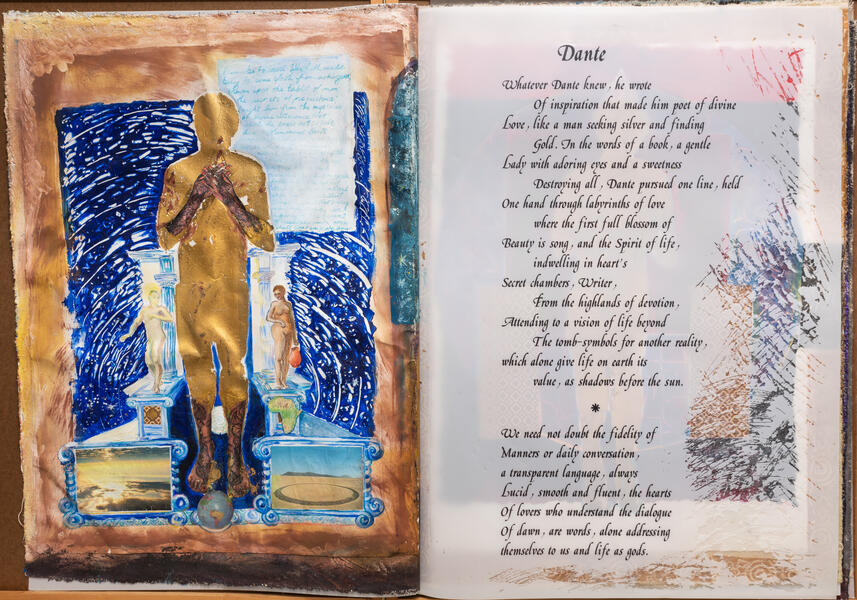 Sacred Geometry pageThe beginning ○ Dante poem by Donna Denize ○ 52"x 68" (open book) ○ (two pages) acrylic on canvas and mylar
Sacred Geometry pageThe beginning ○ Dante poem by Donna Denize ○ 52"x 68" (open book) ○ (two pages) acrylic on canvas and mylar -
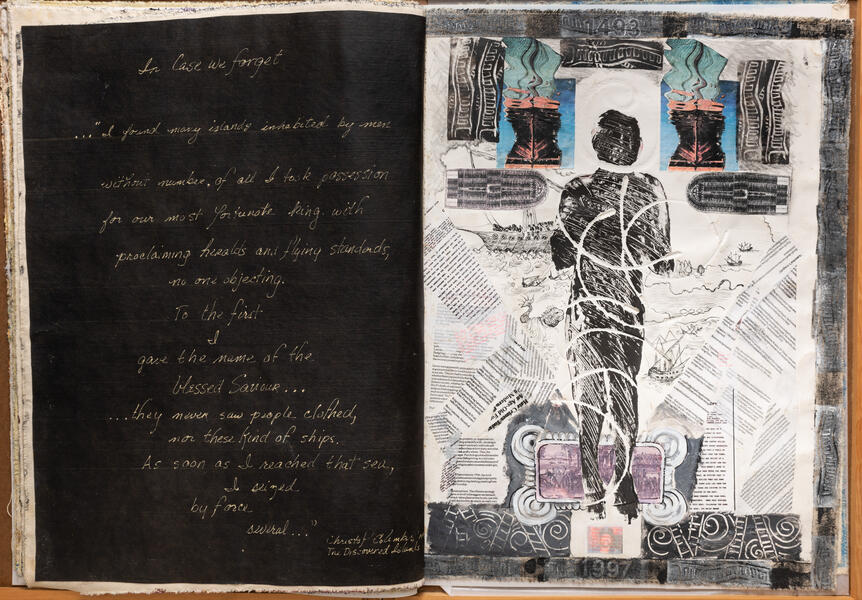 Less we ForgetPage from Sacred Geometry ○ 52"x 34" ○ acrylic on canvas and mylar
Less we ForgetPage from Sacred Geometry ○ 52"x 34" ○ acrylic on canvas and mylar -
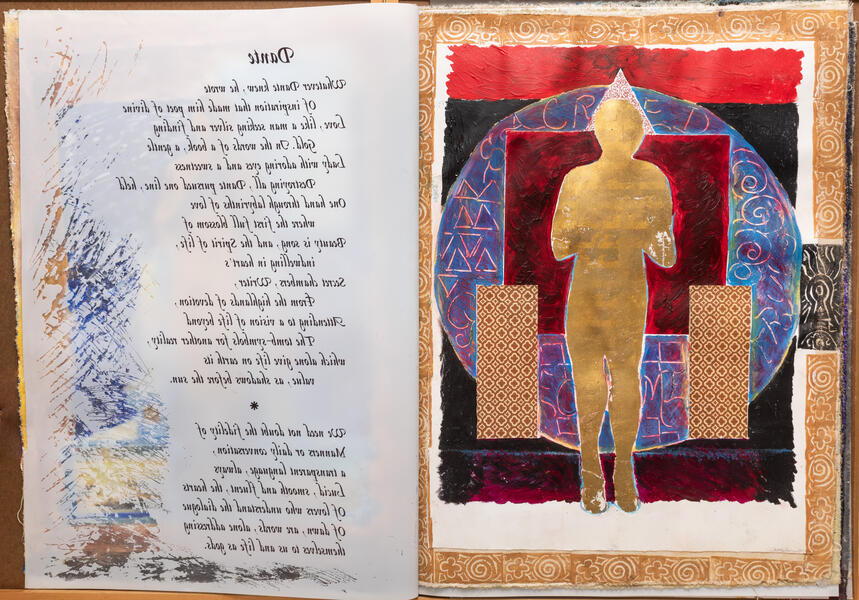 Sacred GeometrySacred Geometry ○ 52"x 34" ○ acrylic on canvas and mylar
Sacred GeometrySacred Geometry ○ 52"x 34" ○ acrylic on canvas and mylar -
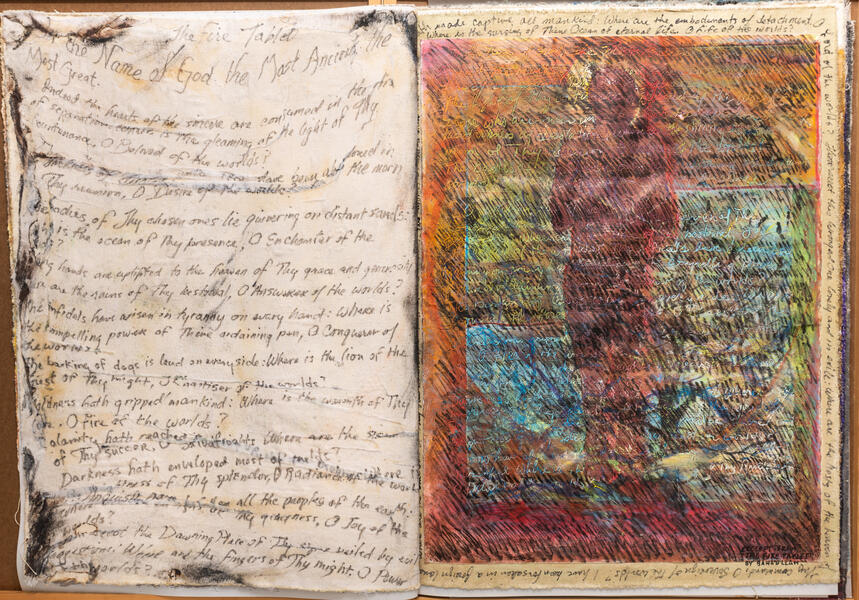 Sacred GeometrySacred Geometry (Fire Tablet) ○ 52"x 68" open book
Sacred GeometrySacred Geometry (Fire Tablet) ○ 52"x 68" open book -
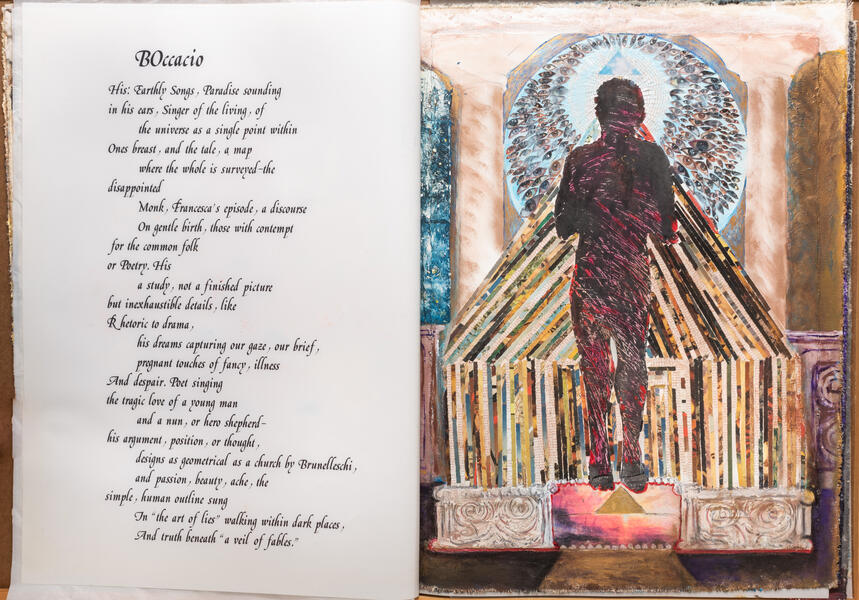 Sacred GeometrySacred Geometry: Boccacio ○ 52"x 68" ○ acrylic, paper on canvas
Sacred GeometrySacred Geometry: Boccacio ○ 52"x 68" ○ acrylic, paper on canvas -
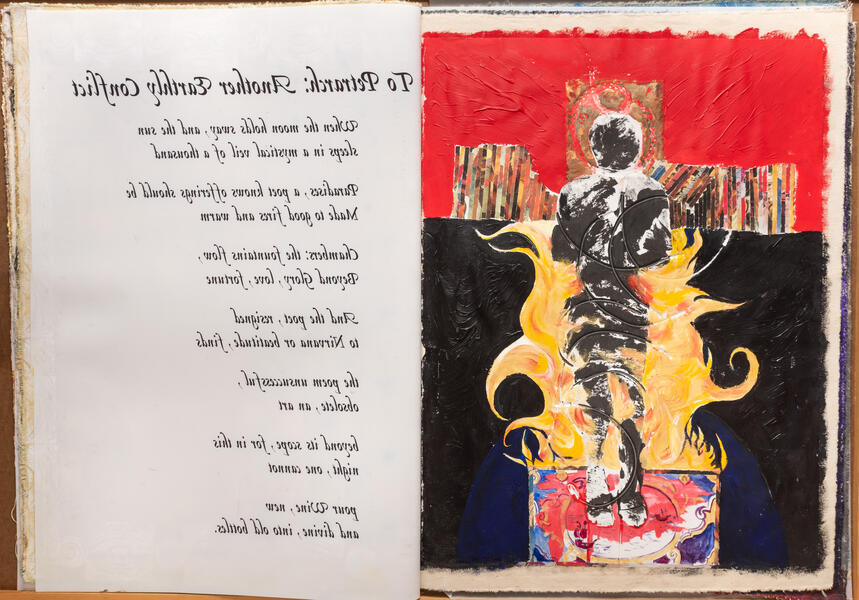 Sacred GeometrySacred Geometry: fire next time 26"x34"
Sacred GeometrySacred Geometry: fire next time 26"x34" -
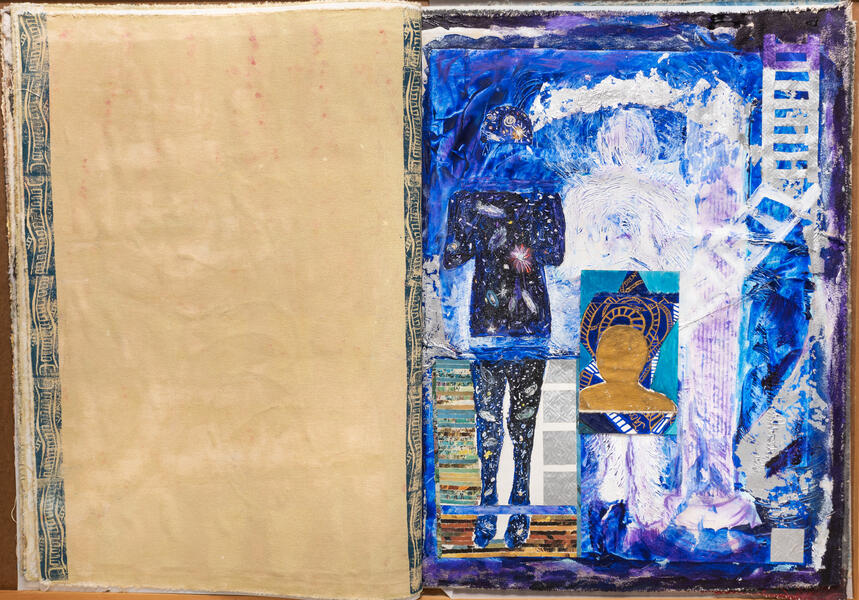 Sacred GeometrySacred Geometry: the universe within ○ 26" x 34" ○ acrylic, paper on canvas
Sacred GeometrySacred Geometry: the universe within ○ 26" x 34" ○ acrylic, paper on canvas -
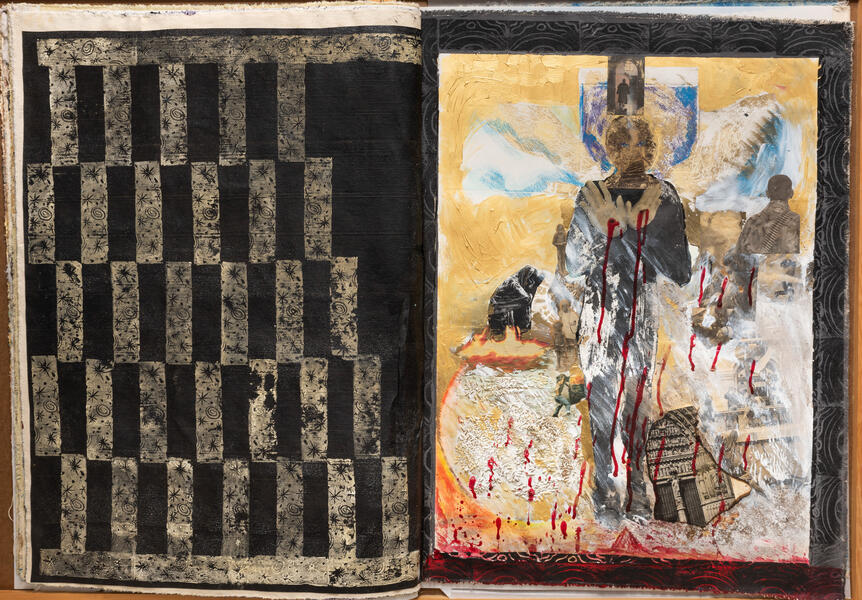 Sacred GeometrySacred Geometry: Rumors ○ 26"x 34" ○ acrylic, paper, rice on canvas
Sacred GeometrySacred Geometry: Rumors ○ 26"x 34" ○ acrylic, paper, rice on canvas -
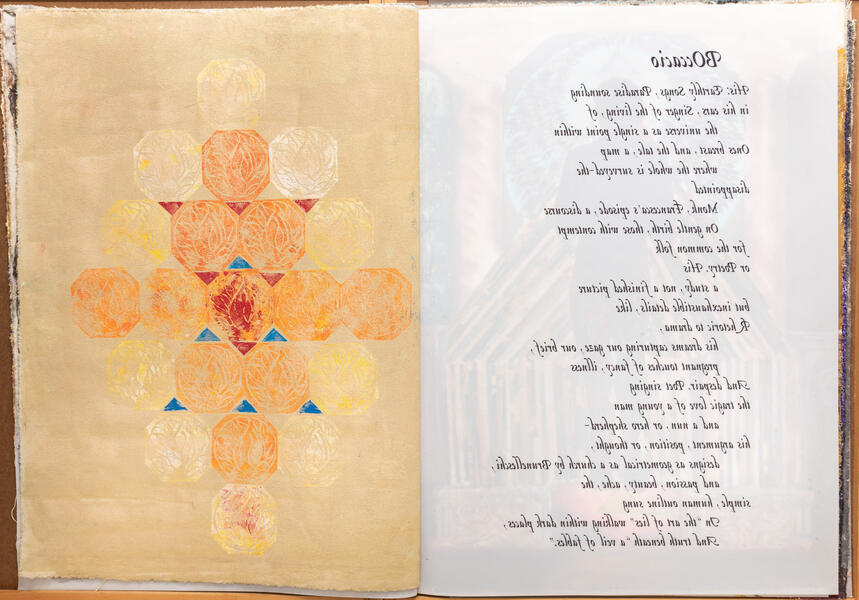 Sacred Geometry
Sacred Geometry
Assemblage
Within DeVane’s psyche, combined with her technical prowess for assemblage, she remembers and reimagines found, castoff materials. These works are conceived by the technique of bricolage with which she leverages the use of available materials. Those materials fuel and load her sculptures with symbolic signifiers of intangible and often uncontrollable, inexplicable forces, which include the crucial dynamics of being human and coexisting with otherworldly beings.
- Dr. Leslie King-Hammond
______
DeVane’s skill in working with “found objects, beads, clay, glass and other materials,” as she “invoke[s] the spirit and are personal prayers, stories or myths...Like that of DeVane’s fellow Baltimorean artist Joyce J. Scott, DeVane’s “interest in diverse cultural interpretation of universal myths is a search for spiritual connections using personal visual references to create mythologies.”
Such connections can be found in Kronos/Collateral (2018), in which Central American celebrations of the dead—where bodies are disinterred and venerated26—and Greek mythology combine to tell the myth of the ancient Greek titan Kronos (Cronos), who devoured his children to circumvent a prophecy that they would depose him. Although the children were eventually disgorged through the intervention of other gods, DeVane casts them as the “collateral damage,” the often innocent and incidental victims in war. Surmounted by a skull (which eerily retains wisps of air), toy soldiers struggle freeform within its skeletal hands in a fall from grace reminiscent of Michelangelo’s in the Sistine Chapel. The additional elements of a miniature missile, tank, and plane and a pyramidal base decorated with beaded bands of blue, white, and red, along with white stars on a blue background, create an allegory of contemporary global war.
DeVane’s Healer (Pilgrimage) (2018) may be said to be a metaphor for the artist’s creative journey. The head of a seeker extends outward from one side of the house-like shrine, suggesting that, like the artist, this entity is eager to receive beliefs and ideas from the various cultures that DeVane renders in forms that actuate their potential. Indeed, in the social practice projects she has undertaken in more recent years in Haiti (where she is working on a public mural) and Hawaii (where she is doing a project with female prisoners), DeVane reveals her determination to explore the philosophical, moral, and ethical focuses of those beliefs and ideas not only in the totality of her work but out in the world.
For DeVane, therefore, art-making is inseparable from her sense of self, her vision of her place on this earth, and her conception of why she is here at this particular moment. Perhaps artist Sylvia Benitez said it best: DeVane’s work reflects choices that are not mirroring others' contributions, but that are the results of a human being who is actually trying to say something about what she feels deeply about.... Personal, explorative, measured with a mature sensitivity to very important issues about race, the human race, all of us...her work is in communion with the source, the spring, and it drinks deeply...She speaks the language of our beginnings, and through this, connects spirit to purpose and purpose to love.
- Dr. Lowery Stokes Sims
-
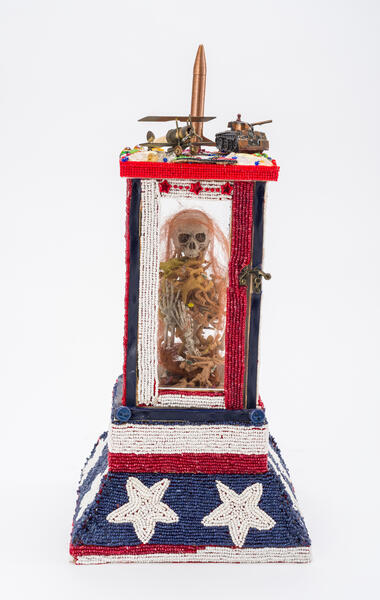 Kronos/CollateralKronos/Collateral ○ 2018 ○ 20" x 9" x 9" mixed media
Kronos/CollateralKronos/Collateral ○ 2018 ○ 20" x 9" x 9" mixed media -
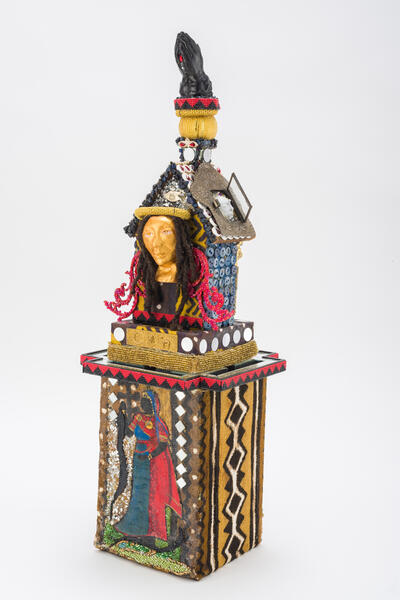 The HealerThe Healer/Pilgrimage ○ 2018 ○ 30" x 10"x 10" ○ assemblage fabric, mirror, clay
The HealerThe Healer/Pilgrimage ○ 2018 ○ 30" x 10"x 10" ○ assemblage fabric, mirror, clay -
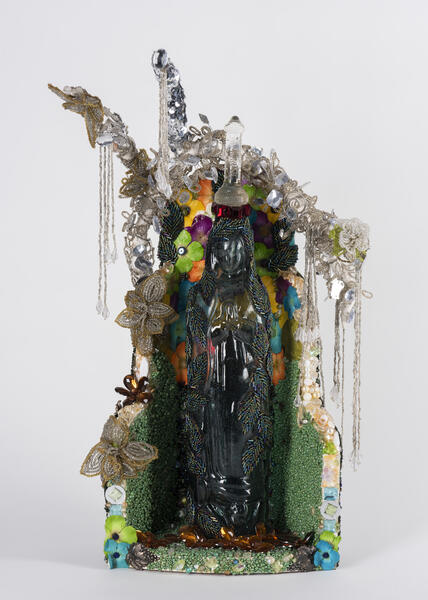 ErzulieErzulie ○ 2016 ○ 18"x 6" x 6" ○ assemblage
ErzulieErzulie ○ 2016 ○ 18"x 6" x 6" ○ assemblage -
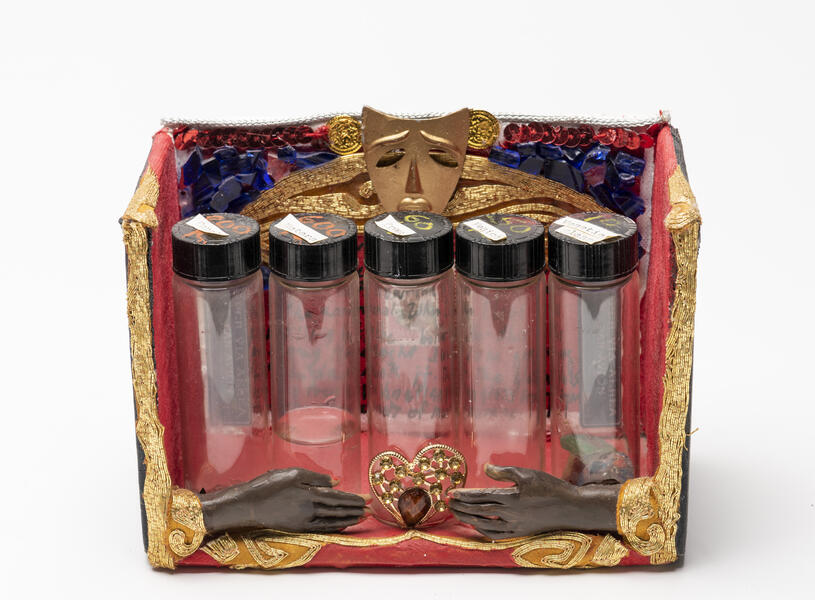 Venetian WatersVenetian Waters (postcard series) ○ 2012 ○ 6" x 4" x 4" ○ mixed media
Venetian WatersVenetian Waters (postcard series) ○ 2012 ○ 6" x 4" x 4" ○ mixed media -
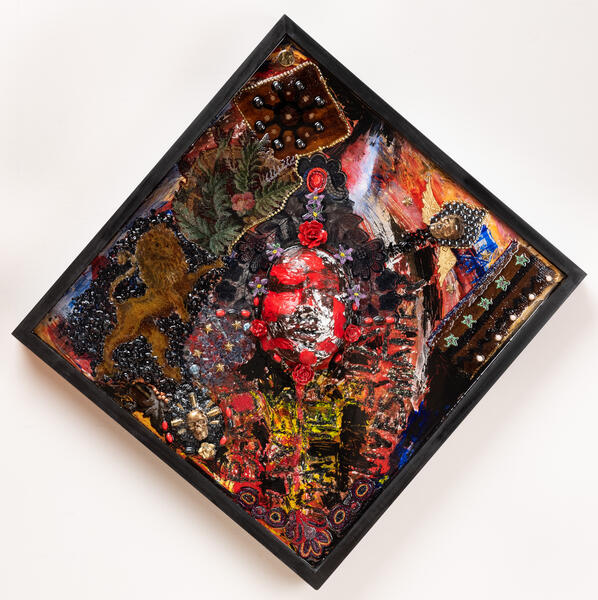 Crossroads BLMCrossroads (BLM) ○ 2019 ○ 30" x 30" x 2" ○ fabric, beads, plaster, acrylic
Crossroads BLMCrossroads (BLM) ○ 2019 ○ 30" x 30" x 2" ○ fabric, beads, plaster, acrylic -
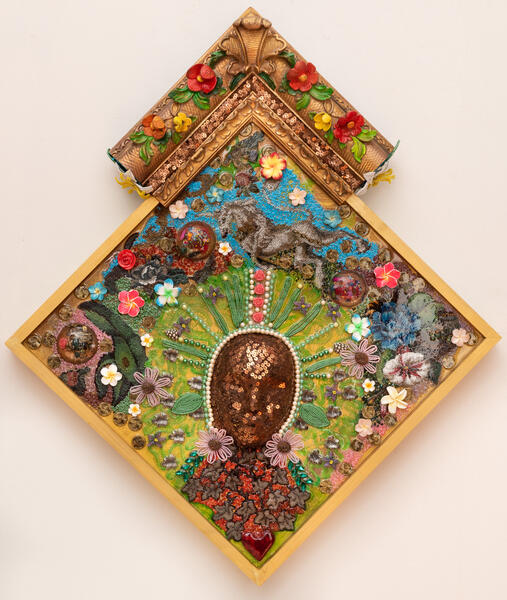 Earth MotherEarth Mother ○ 2018 ○ 36" x 30" x 6"○ beads, fabric, resin, plastic, wood
Earth MotherEarth Mother ○ 2018 ○ 36" x 30" x 6"○ beads, fabric, resin, plastic, wood -
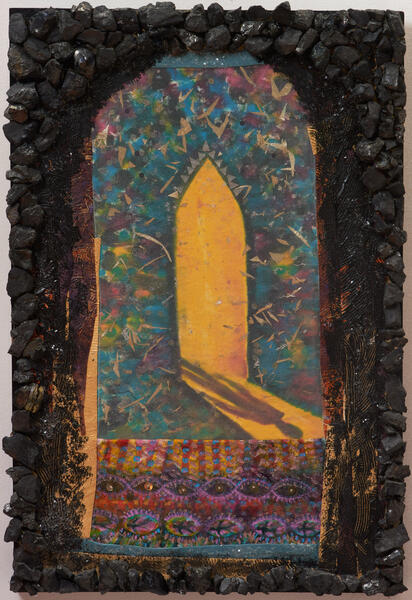 Doorway to NowhereDoorway to Nowhere ○ 1980 ○ 24" x 30 " ○ acrylic, charcoal, fabric
Doorway to NowhereDoorway to Nowhere ○ 1980 ○ 24" x 30 " ○ acrylic, charcoal, fabric -
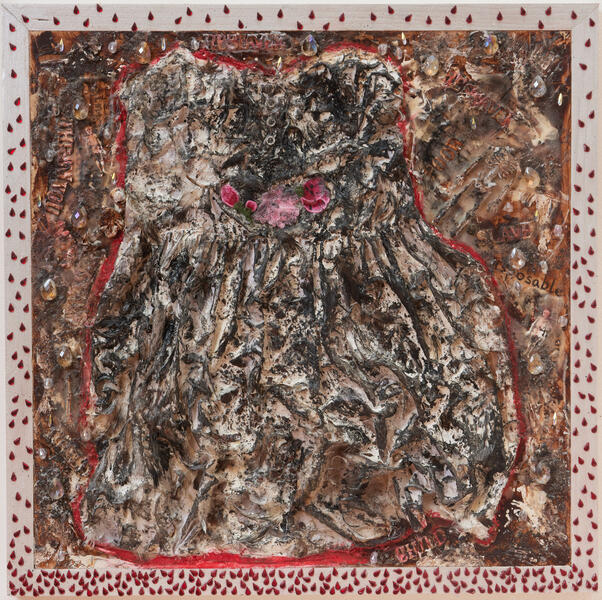 RestavekRestavek ○ 2016 ○ 30" x 30" x 2" ○ encaustic, fabric, plastic, glass, feathers, beads
RestavekRestavek ○ 2016 ○ 30" x 30" x 2" ○ encaustic, fabric, plastic, glass, feathers, beads -
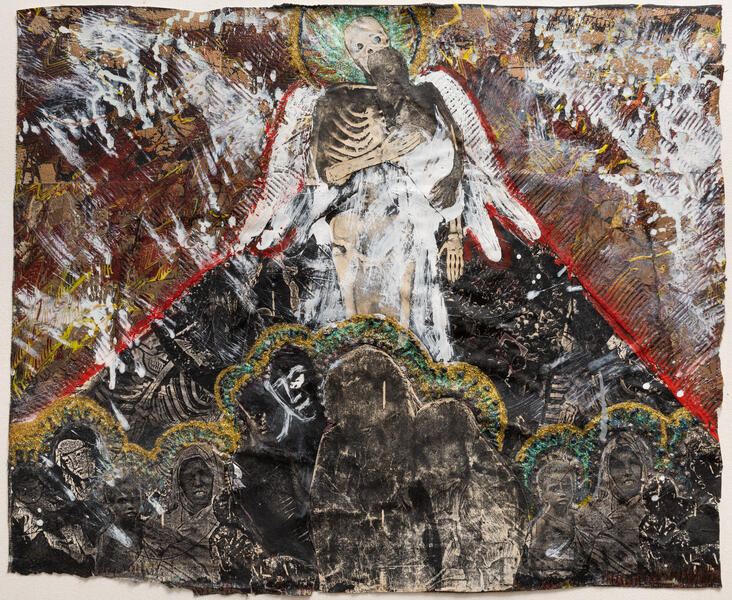 she'll come for us tooshe'll come for us too ○ 1995 ○ 24" x 30" ○ collage
she'll come for us tooshe'll come for us too ○ 1995 ○ 24" x 30" ○ collage -
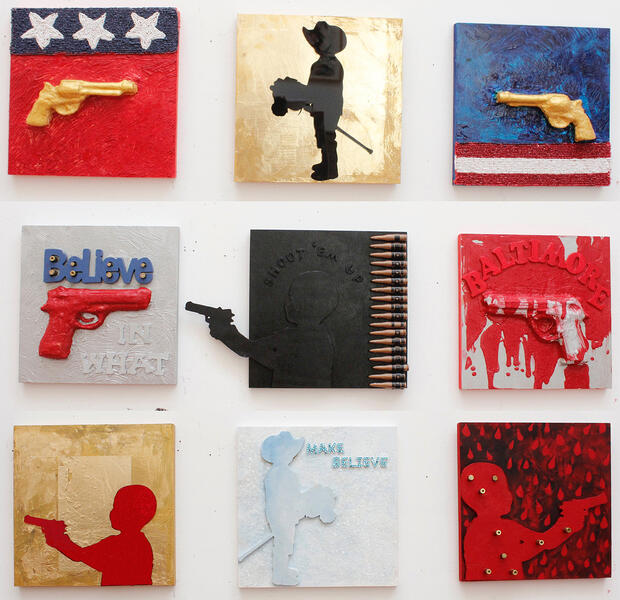 Child's Playnine 12" x 12" mixed media panels ○ 2015
Child's Playnine 12" x 12" mixed media panels ○ 2015
Painting
Excerpted from an interview conducted on December 4th, 2018 with Virginia Anderson for BMA/Stories—
Anderson: You’ve mentioned before that your father was an important role model for you in becoming an artist. Can you tell me a little bit about him and your relationship with him?
DeVane: My dad worked at Bethlehem Steel. He had strong opinions and personality, and he loved talking about art and exposing us to black writers. He took my brothers, sister, and me to a Martin Luther King March in D.C., and to the Poor People’s March in the ’60s. When he realized I was going to art school, he insisted, “You know, there are black artists out there. You’ve got to learn about people like Jake Lawrence and Romare Bearden.”
He was the first in his family to go to college and was really into what artists were doing. Sometimes he would come home, set up an easel in the dining room, and paint. I wish I had some of his paintings now. I remember one of his paintings of Noah and the flood, and another of Ezekiel. They were always somehow related to biblical stories, and he ended up giving one to a little corner church we used to go to as kids. He did a self- portrait that was pretty fabulous. Our family house in Catonsville flooded one year and we lost everything. All we had stored in the basement was irretrievable. To have lost that part of him has always been something my sister and I talk about. He was highly intuitive artistically, but he had lots of skills I admired. It was this visual language that was coming out of this person whose labor was just so ordinary.
____
I’ve always loved color and textures. Bringing the extraordinary into being is a struggle and I've wanted to surpass mundane representation of ideas. The framework of painting has just been another language, through which I experiment with materials and search to find meaning.
-
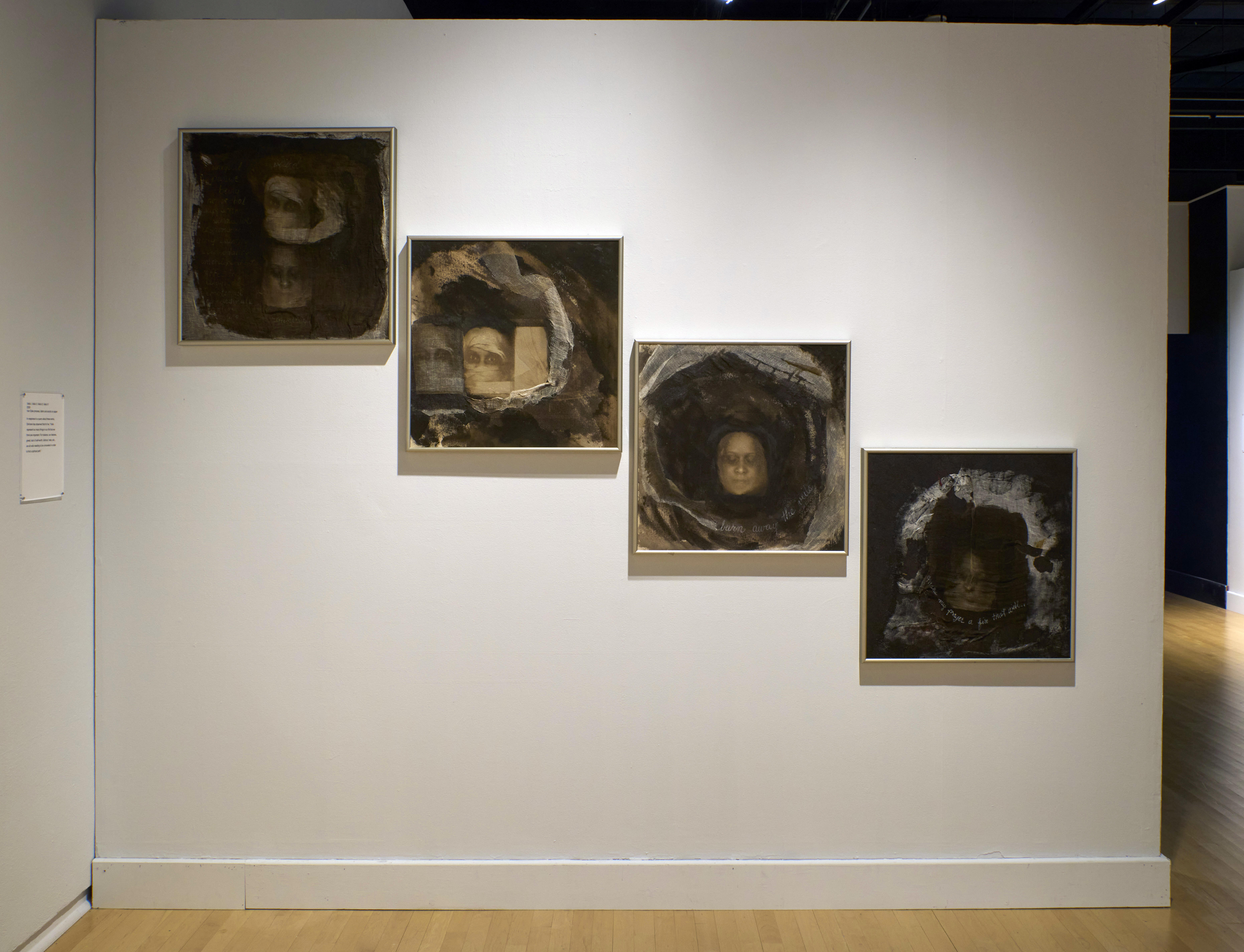 Veils I,II,III,IVVeils I, II, III, IV. ○ 2000 ○ Vandyke process, fabric and acrylic ○○ Represent so many things in our life that we think are important. Our desires, greed, lack of self worth, distrust, etc. Veils that need to unravel to find our true selves.
Veils I,II,III,IVVeils I, II, III, IV. ○ 2000 ○ Vandyke process, fabric and acrylic ○○ Represent so many things in our life that we think are important. Our desires, greed, lack of self worth, distrust, etc. Veils that need to unravel to find our true selves. -
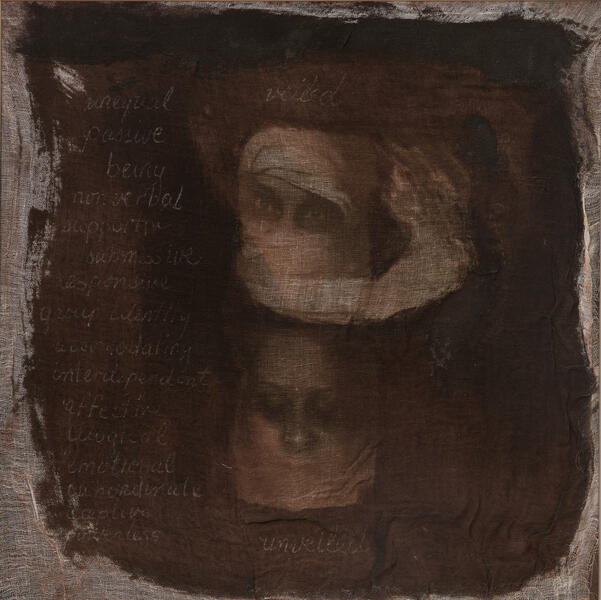 Veils IVeils 1 ○ 2000
Veils IVeils 1 ○ 2000 -
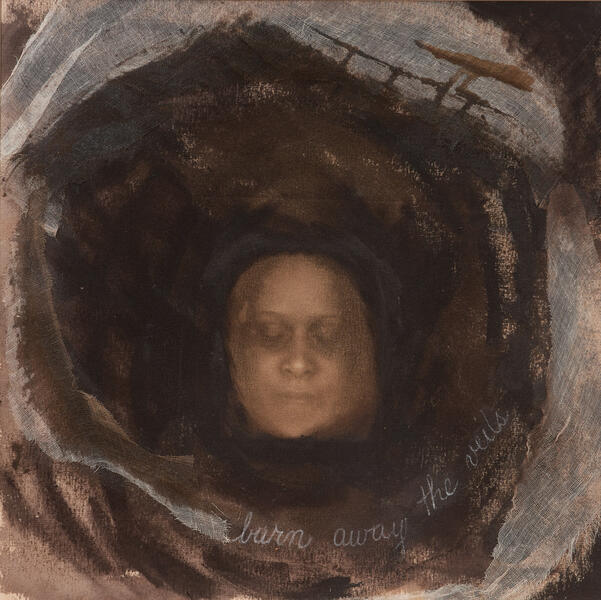 Veils IVVeils IV ○ 2000 ○ Vandyke process, fabric and acrylic
Veils IVVeils IV ○ 2000 ○ Vandyke process, fabric and acrylic -
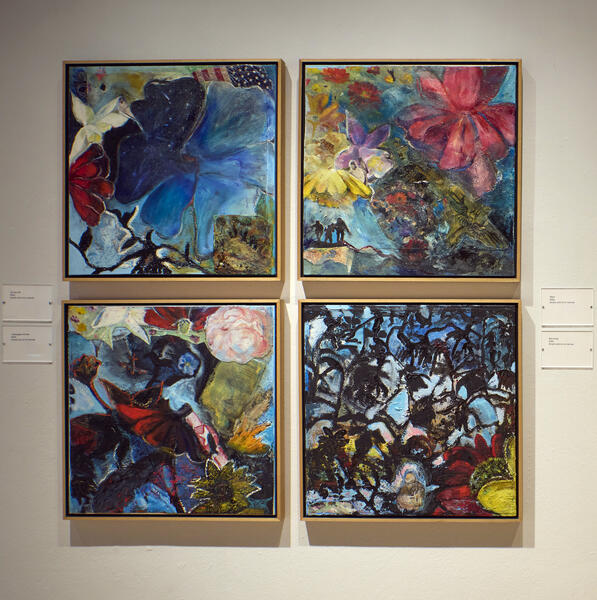 Tuskegee AirmenTuskegee Airmen ○ 2003 ○ Oil on canvas collaged ○ each panel 4' x 4'
Tuskegee AirmenTuskegee Airmen ○ 2003 ○ Oil on canvas collaged ○ each panel 4' x 4' -
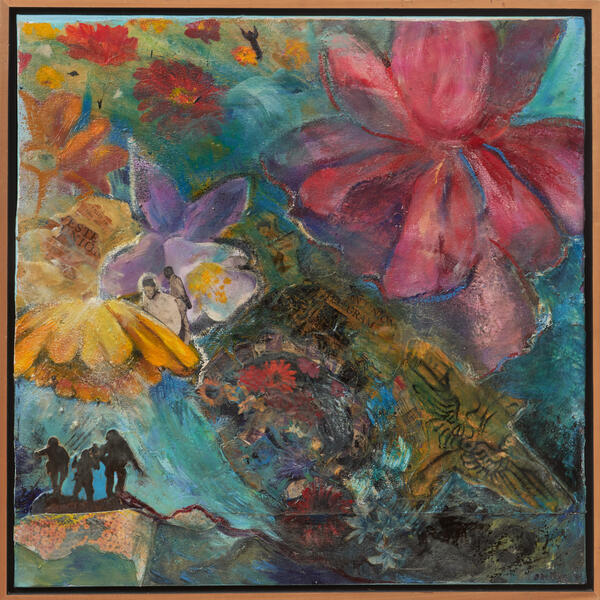 Tuskegee AirmenTuskegee Airmen ○ 2003 ○ oil on canvas
Tuskegee AirmenTuskegee Airmen ○ 2003 ○ oil on canvas -
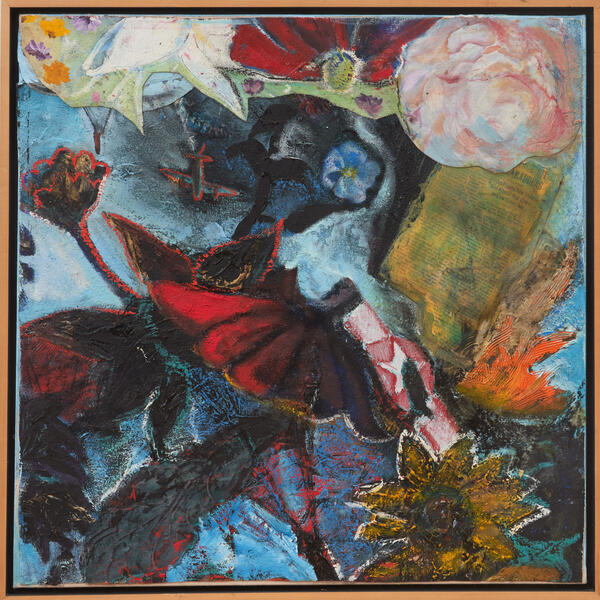 Tuskegee Red TailsTuskegee Red Tails ○ 2003 ○ oil on canvas
Tuskegee Red TailsTuskegee Red Tails ○ 2003 ○ oil on canvas -
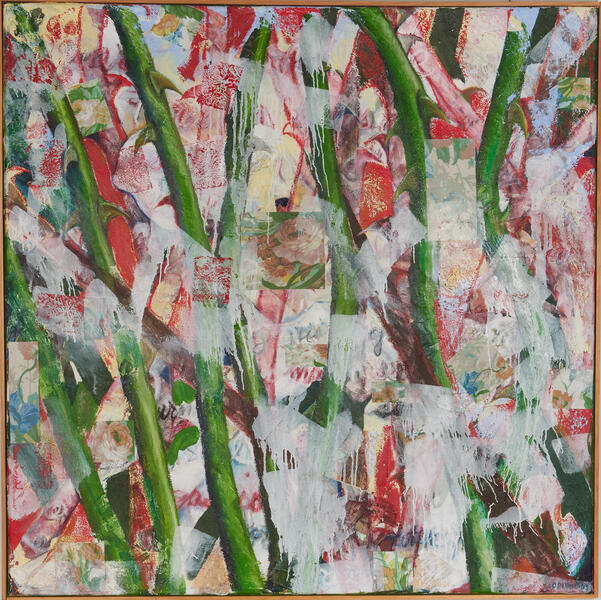 Love LettersLove Letters ○ 2004 ○ oil and fabric on canvas ○ 54"x54"
Love LettersLove Letters ○ 2004 ○ oil and fabric on canvas ○ 54"x54" -
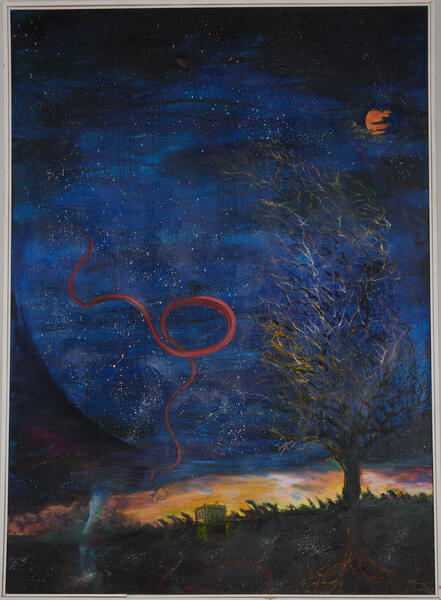 I want to fly awayI want to fly away ○ 2009 ○ oil on canvas ○ 45" x 60"
I want to fly awayI want to fly away ○ 2009 ○ oil on canvas ○ 45" x 60" -
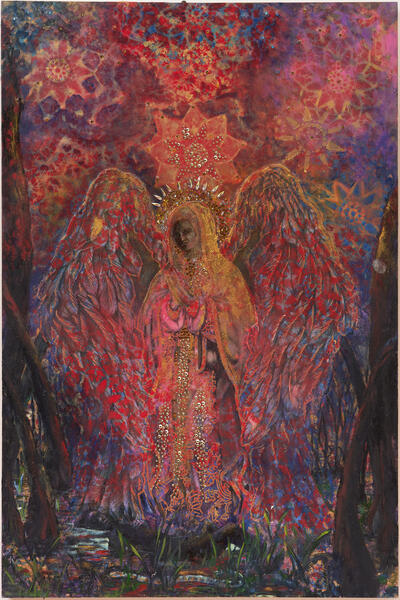 Swamp angelSwamp Angel ○ acrylic on panel, mixed media
Swamp angelSwamp Angel ○ acrylic on panel, mixed media -
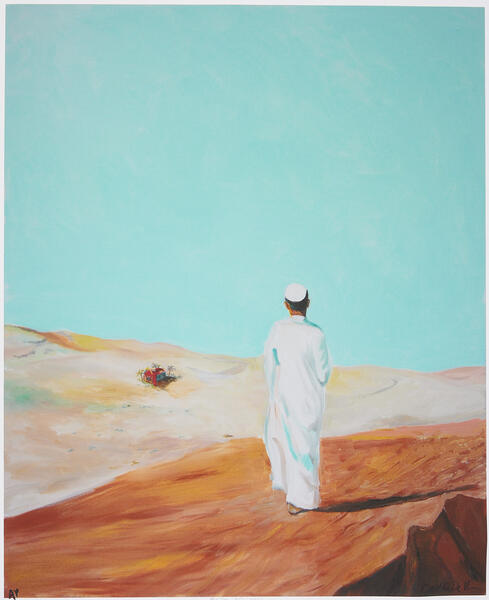 McDonald's Oasis-(Abu Dhabi)McDonald's Oasis (Abu Dhabi) ○ 2015 ○ 56"x 60" ○ acrylic on canvas
McDonald's Oasis-(Abu Dhabi)McDonald's Oasis (Abu Dhabi) ○ 2015 ○ 56"x 60" ○ acrylic on canvas
Beyond Bars
The BEYOND BARS project has supported the critical work of the Women's Community Correctional Center for nine years by adding value as the women recover from trauma, substance abuse, and mental health issues. Every offender has a story, comprising 258 pre-trial or sentenced inmates; whether they are maximum, medium and minimum custody levels. The facility utilizes a trauma informed framework to create a supportive and comprehensively integrated environment. BEYOND BARS was a proposal to change the public perception of female offenders through its artistic effort to document the stories of the women, some who are criminally violent and others are more likely to suffer from mental illnesses.
-
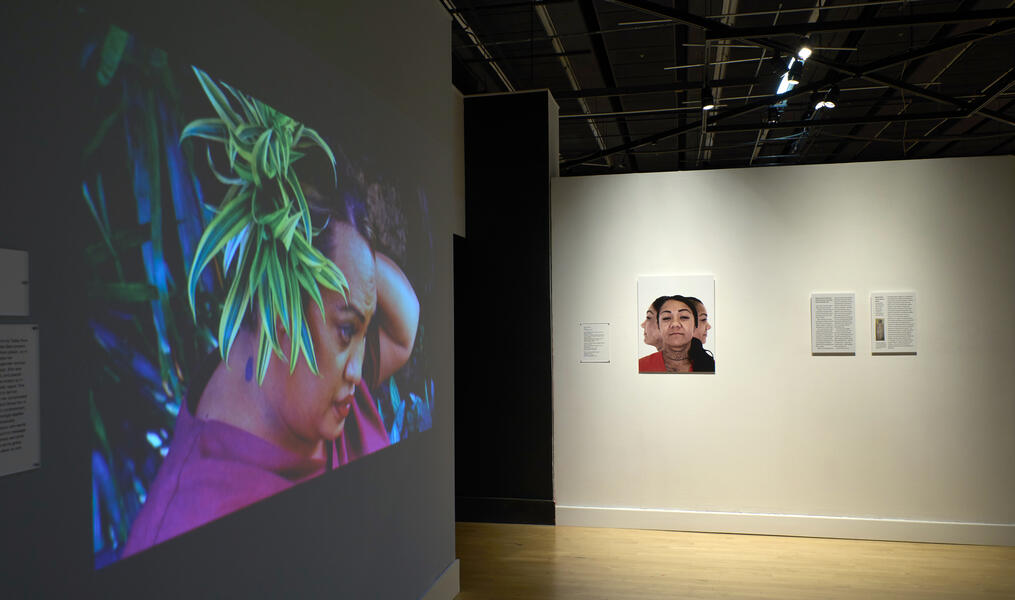 Beyond Bars ○ Installation View
Beyond Bars ○ Installation View -
Dion'e: Searching for SelfThe Prison Monologues Project is an ambitiously scaled project that supports the Women’s Correctional Center in Kailua, Hawaii which embraces the philosophy that prison should be a place of healing. I was a volunteer for four days of my stay in Hawaii and during that time I met several women who were parolees trying to reintegrate into their community. I took over 200 photographs of two women, listened and recorded their stories as part of the Prison Monologues video portraits. Many of the women have had traumatic lives and are slowly healing.
-
Fili's SongFili is a vocalist and chose to reveal her past, present and future as a song. This video will be at the end the video series.
-
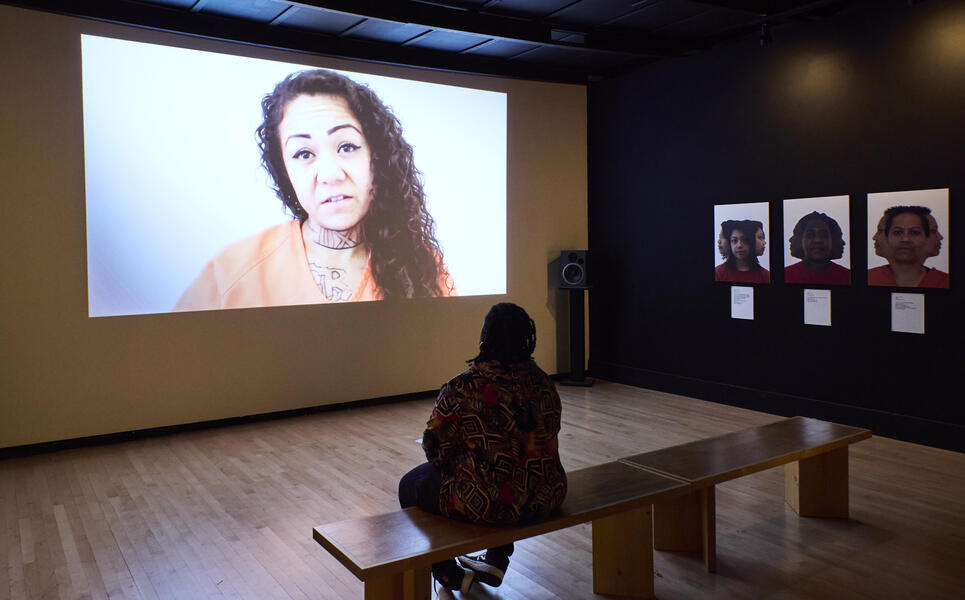 Beyond Bars- Installation View (II)
Beyond Bars- Installation View (II) -
Tiana“A Baby Having Babies” (Video) ○ Falling into drugs after her first child at 13 years old, Tiana tried taking the easy way out of her problems, but running from the law left her with two prison sentences and the loss of all her children. Wanting to fit in led down a dangerous path where she continues to serve her ninth year for an original five-year term.
-
 Tiana ○ Tuttle GalleryVideo and Photographic Hecate Print
Tiana ○ Tuttle GalleryVideo and Photographic Hecate Print -
 Tiana
Tiana -
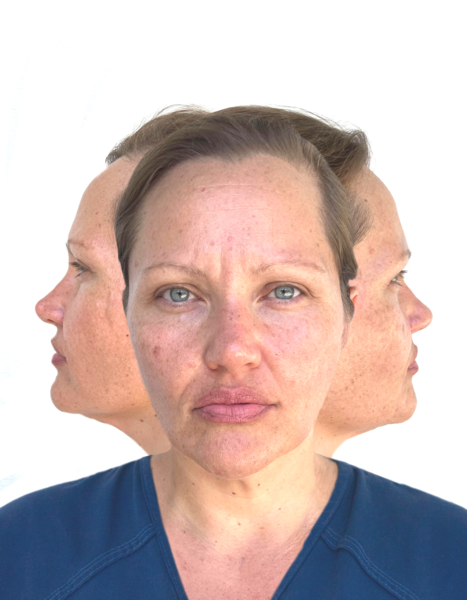 Zoe
Zoe -
 Momi
Momi -
 Angie
Angie
Interviews & Panels
Some recent publications include:
BmoreArt | Ten Best Baltimore Exhibits for 2022
Baltimore Sun | Baltimore native artist Oletha DeVane’s new Lexington Market sculpture aims to capture the history of slavery
WYPR | Art Matters: Christopher Bedford with Oletha DeVane
BMA Stories | ARTIST OLETHA DEVANE ON MATERIALS AND THE MEANINGS THEY HOLD
Baltimore Sun | ‘Complex legacy’: A Baltimore County private school considers how to remember those enslaved by its founder
-
Oletha DeVane: Exploring Presence
-
Oletha DeVane at Morgan State University
-
Panel Discussion - Oletha DeVane: Spectrum of Light and Spirit, 2022
-
Tea with Myrtis: Artistically Speaking with Oletha DeVane
-
Oletha Devane: Woman as Color, Light and Form
-
Panel Discussion: Art From the Inside
-
OLETHA DEVANE, Advocate
-
New McDonogh School memorial honors enslaved people





















































































